How To Determine What Port Citrix Vda Registered On
Are y'all interested in the new Windows 365 cloud PC service? Delight read Get started with Windows 365 – Microsoft Tech Community to learn more!
The new Azure Virtual Desktop (AVD) Azure Resource Manager (ARM) based model is at present Generally Available for everyone – and the involvement is enormous. It addresses a lot of customer feedback, such as extra management (GUI) capabilities, AAD grouping back up, metadata location changes and more… AVD can be a good fit for different kind of scenario's to enable remote working.
In this article, I'd like to cover the deep(er) technical points, while some are only not part of the public message but still way too important not to share. It'll hopefully assist you equally consultant or architect to bring the technical (and functional) message around Azure Virtual Desktop – ARM-based to your customers 😊! Continue reading…
Table of Contents
Click on the title to jump to that spot in this article:
- New! Windows in the Cloud – video testify with Christiaan Brinkhoff
- Windows in the Cloud – become started with Windows 365 cloud PC
- Azure Virtual Desktop at Enterprise scale – documentation
- Azure Virtual Desktop Deployment Recommendations and Best Practices webinar
- New Azure Portal – Dashboard
- Differences between AVD non-ARM and ARM
- New user management options
- Custom RDP Settings via Azure Portal
- Delegated Access via Azure RBAC – Access command (IAM)
- New PowerShell Modules
- Manage Azure Virtual Desktop via Microsoft Endpoint Manager (MEM)
- MSIX app attach (via the Azure Portal) – The future of app delivery
- Azure Virtual Desktop and Azure Log Analytics
- Screen Capture Protection
- Azure Automation – auto-scaling tool
- First VM on Connect
- One time more than – What is Azure Virtual Desktop?
- The compages behind it all
- AVD User connexion Traffic Flow
- Azure Virtual Desktop service network access requirements
- Mensurate your latency – tools
- RDP Shortpath
- Manage Windows 10 multi-session via Endpoint Manager (MECM)
- What almost GPUs?
- Azure Virtual Desktop – ARM based portal enrolment process
- Pre-requisites for Azure Virtual Desktop
- Create an custom Windows 10 multi-session prototype
- Install OneDrive Per-Machine
- OneDrive Known Folder Movement – modernize your profile
- Install Teams with AV Redirection media optimizations
- Add together language packs
- Add FSLogix Profile Container as profile delivery solution
- Boosted image optimizations
- Sysprep the image
- Capture the custom – Azure Managed – epitome
- Optimize your images with the Virtual Desktop Optimization tool
- Create an Azure Shared Prototype Gallery (SIG)
- Perform the Microsoft.DesktopVirtualization resource provider registration
- Create a host pool
- VM details
- Administrator account
- Create the Workspace
- Select your image type
- Network and Security
- Start enrolment
- Create and Assign Remote Applications (to AAD Groups!)
- Expand your existing host puddle with new session hosts
- Update the host puddle images – create a new paradigm version
- Change the proper noun of your Workspace
- Modify the proper noun of your Virtual Desktops
- Install the Azure Virtual Desktop Client
- Do y'all prefer to enter your organization's e-mail?
- Deploy the Remote Desktop Customer via Microsoft Endpoint Manager – Intune
- Utilise the HTML5 Web portal
- Want to see everything above in activity?
Users want technology that is familiar, piece of cake to use and always available so they can work and create fluidly across devices. cloud PC makes this possible by combining the power and security of the deject with the familiarity of the PC. Merely Microsoft can bring together the PC and the cloud with a consequent and integrated Windows experience. Introducing Windows 365. Windows 365 is the world'south first deject PC. With a deject PC, Windows evolves from a device-based OS to hybrid personalized computing.
A cloud PC is your personalized desktop, apps, settings, and content streamed deeply from the cloud to your devices. It enables you to decrease costs while lowering the complication of your environment as you deploy and manage virtual endpoints in Microsoft Endpoint Manager. No boosted virtual desktop infrastructure (VDI) expertise or resource are needed.
In add-on, Windows 365 enables you to:
- Procure, provision, and deploy in minutes, with optional automated OS updates.
- Offers user anywhere admission to their personalized Windows desktop feel.
- Tailor compute and configurations for an elastic workforce.
- Pick up where you left off on the device of your choice.
- Optimize experiences on Windows endpoints.
- Scale confidently with per-user pricing.
Removes the complication of traditional VDI deployments
With Windows 365, all the building blocks are automated for you lot and we make sure that the service scales with y'all in the about optimized style possible to utilize Microsoft 365 apps. Information technology is Microsoft'due south best expression of Windows and Microsoft 365 and is always secure and up to date.
The cloud PC tin be accessed anywhere from any device and tin can scale with a user'southward irresolute compute needs, pregnant that the user could receive the self-service privileges to release an IT admin from assigning a license that provide more compute resources. The same applies for storage upgrades and cloud PC reboots, more virtually this later.
Read more virtually Windows 365 hither Go started with Windows 365 – Microsoft Tech Community
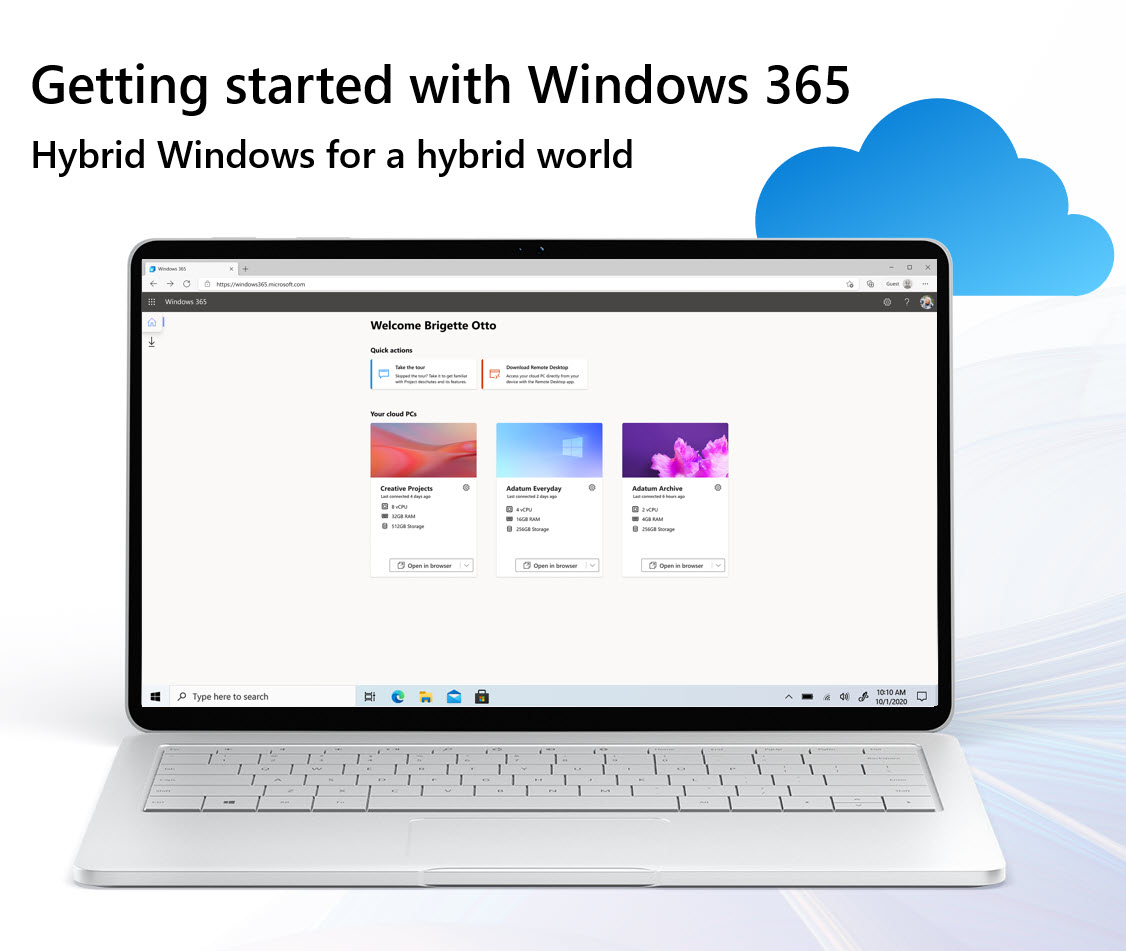
New! Windows in the Cloud – video show with Christiaan Brinkhoff
This alive Microsoft Teams webcast series highlights new features, best practices from both Microsoft Applied science and the customs, and Windows 365 success stories. We hope y'all'll join u.s.a. correct here as we explore technology-focused topics aslope members of the community, Microsoft Engineering, customers, and users.
In episode 1, Jen Gentleman from the Windows Technology team showcases new features to help yous exist more productive in the cloud equally role of Windows 365. The session is fully demo-driven. It gives you an inside view of all the new features and explains how they came into Windows xi, Microsoft's newest operating organization.
Click here for more than information – or watch all the recordings and to see all the new upcoming episodes.

Azure Virtual Desktop at Enterprise scale – documentation
As function of a great Microsft internal field initiative that I led we created two very of import articles on how to use Azure Virtual Desktop besides equally FSLogix at Enterprise scale. The manufactures include tons of all-time practices and tips and tricks that get you up to speed proactively while designing a big virtual desktop infrastructure on Microsoft Azure.
- Azure Virtual Desktop for the Enterprise: aka.ms/wvdbestpractices
- FSLogix for the Enterprise: aka.ms/fslogixbestpractices
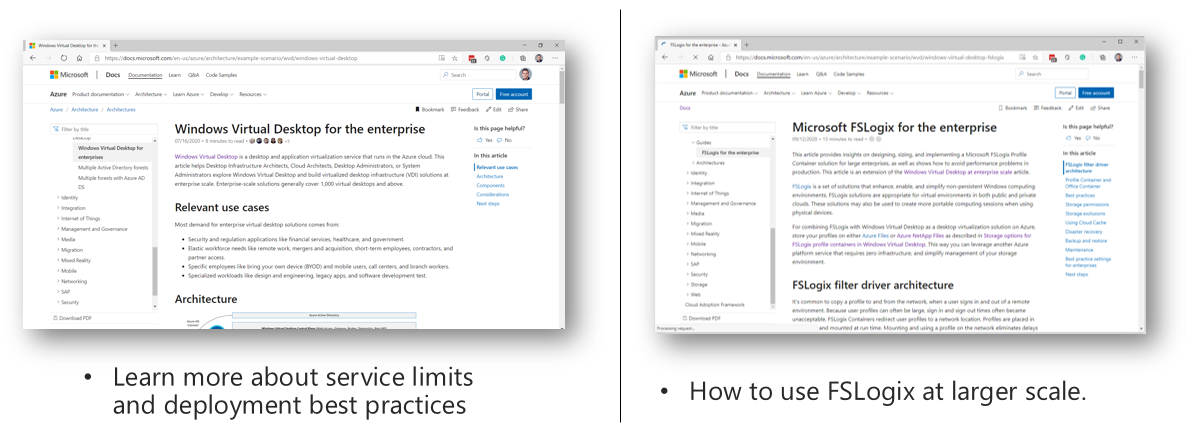
Azure Virtual Desktop Deployment Recommendations and All-time Practices webinar
Recently, I've presented a webinar on the above content. This information could be very valuable for anybody that is using this web log article to kick the tires on Azure Virtual Desktop.
Get guidance on:
- Virtual machine sizing requirements for single and multi-session to help maximize usage and performance.
- Preparing your network for Microsoft Teams to back up remote worker collaboration.
- Managed storage options to optimize FSLogix profile containers for your user and regional requirements.
- Optimizing your host puddle and paradigm gallery setup for the best user experience.
Azure Portal – Dashboard
The new landing page for Azure Virtual Desktop in the Azure portal looks like this. It'southward very slick and steps are dramatically simplified. Previous steps such as consent and PowerShell creation of the tenant are all gone! Learn more than well-nigh it subsequently on in this commodity.

Differences between AVD non-ARM and ARM
The new Management portal integration is completely built on ARM, which ways that permissions can exist managed via role-based admission control (RBAC). All the deployment objects of AVD e.g. host pools, workspaces, etc are objects within your Azure subscription. This makes it easier to manage and automate your environment.
See below the most of import differences and changes of classic AVD (non-ARM) and AVD ARM-based via the Azure Portal.
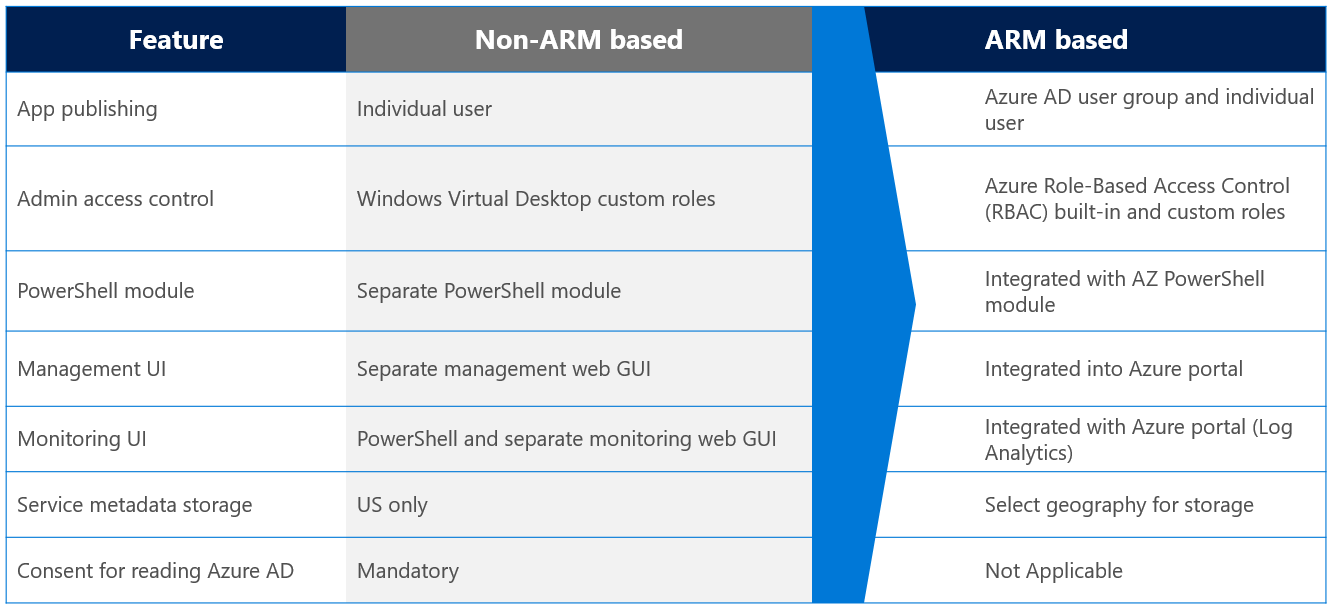
User session direction
With the new ARM-based – jump update release of Azure Virtual Desktop beingness available. We also have the option to practice more than user session troubleshooting directly from the Azure Portal. The users card option gives us the choice to search for users, see their active sessions, awarding consignment, and send them messages during maintenance work.
This allows helpdesk employees to practise some get-go line of back up for Azure Virtual Desktop from the Azure Portal.
Note: If you are interested in learning about the different options to remote control/shadow user sessions, please use 1 of my other blogs equally here to learn more than.

Custom RDP settings
Previously in the non-ARM version of Azure Virtual Desktop, you had to activate RDP settings via PowerShell. In the new ARM-based model it'southward possible to turn for case clipboard or disk drive redirection to align with your company security baselines and perform this pace directly from the Azure portal menu.

Delegated Access via Azure RBAC – Access control (IAM)
Since Azure Virtual Desktop made the shift to Azure Resource Director (ARM), a lot of extra options to delegate admission to your AVD components are possible. This works via RBAC/IAM roles. The role assignment process has three components: security master, role definition, and scope. The new roles are now directly available from the Azure Portal. Learn more most delegation via RBAC roles and Azure Virtual Desktop hither.

PowerShell Modules
Equally part of this release, AVD now also integrates into the AZ PowerShell module. Commands are now starting with e.g. Go-AzWvdDesktop instead of Get-RDSDesktop. This leaves up to all the same create all the Azure Virtual Desktop components completely automated via PoSH. ARM templates for doing the Workspace (tenant), host pools and application group deployments automatic are coming shortly. More data can exist plant here.
Annotation: The new ARM templates for Azure Virtual Desktop ARM-based to automate your deployment are now available for download here.
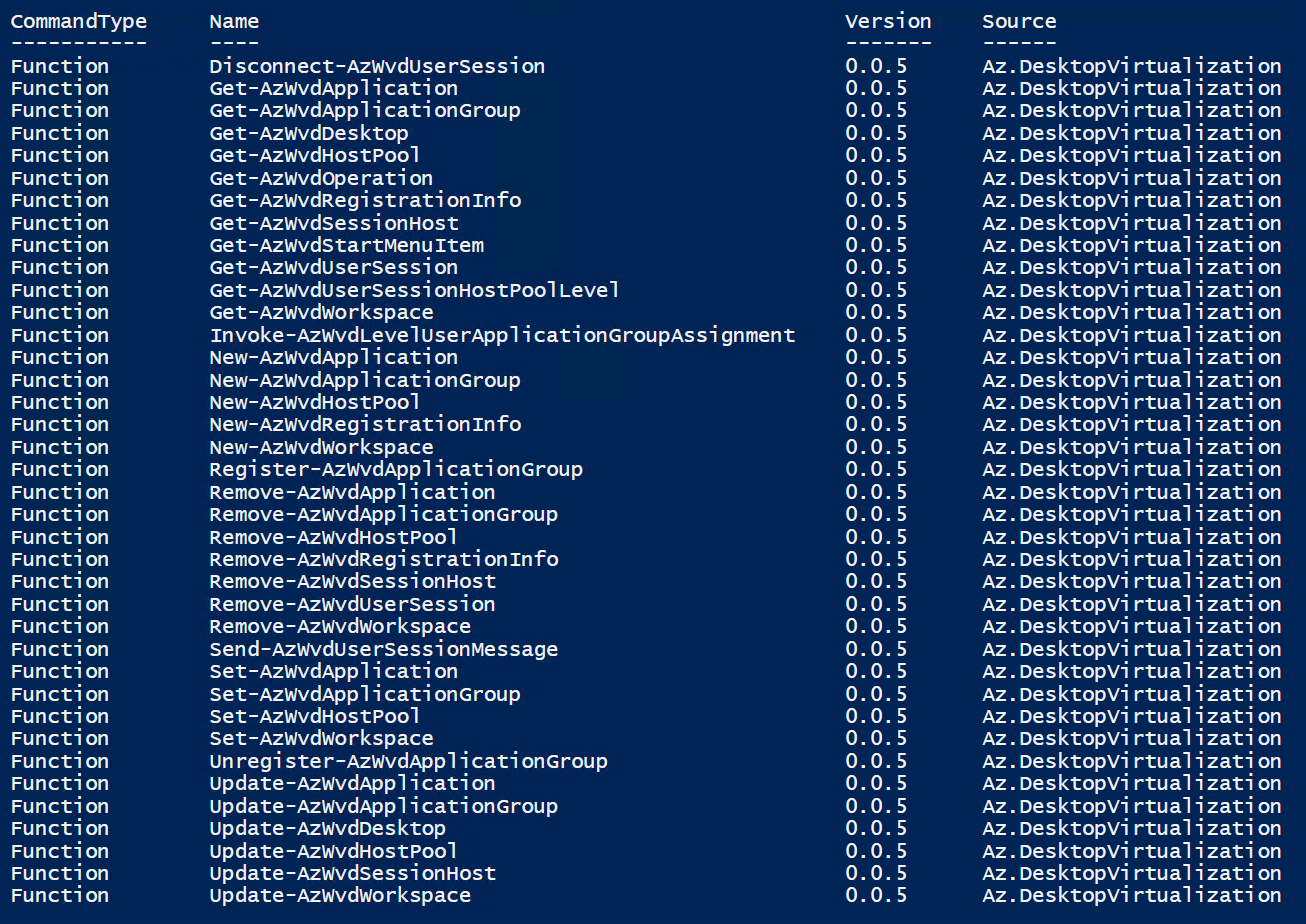
Manage Azure Virtual Desktop via Microsoft Endpoint Manager (MEM)
Microsoft Endpoint Manager allows y'all to manage policies and distribute applications across devices. You tin now enroll Azure Virtual Desktop virtual machines that are hybrid Azure Agile Directory domain-joined (joined to your on-premises Active Directory and registered with your Azure Active Directory) with Microsoft Intune and manage them in the Microsoft Endpoint Director admin center the aforementioned style as concrete devices. This simplifies management, provides a centralized view across both physical devices and virtual desktops and creates new areas of collaboration. The Microsoft Endpoint Manager integration is more often than not bachelor for Windows 10 Enterprise desktops – you can larn more in the public FAQ.
Await more than and more consolidation between physical and virtual desktops in the near futurity. One simplified management console to maintain both physical and virtual desktops!

Run into below Windows 10 Enterprise virtual and physical desktops meeting in Microsoft Endpoint Manager.
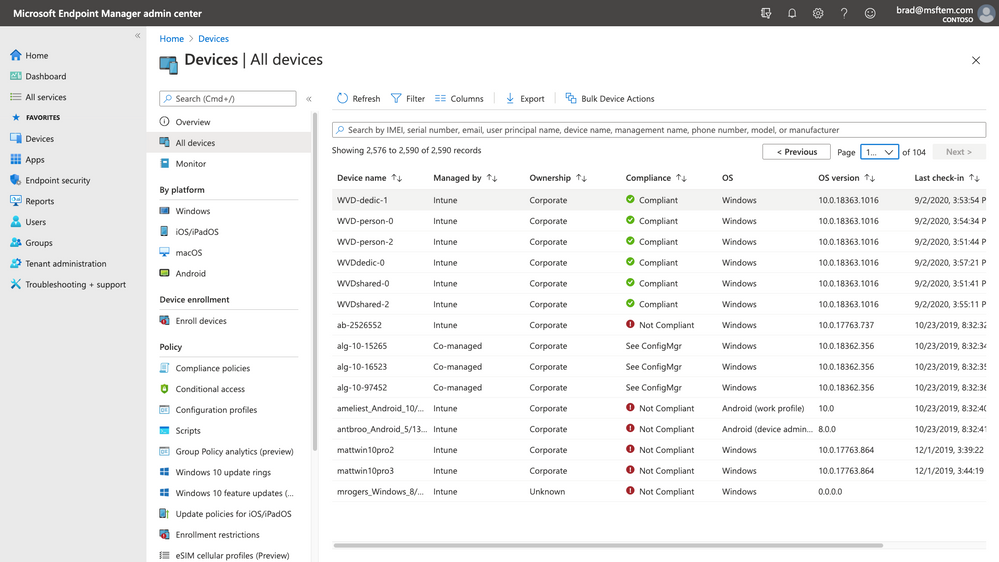
The future of app commitment – MSIX via the Azure Portal now bachelor!
4.13.2021 update – MSIX app attach is now available in GA – ready for production workloads. Read more about the declaration here.
Previously, you had to use PowerShell scripts to enable MSIX app adhere. We will be integrating the app attach capability in the Azure portal and Azure Resources Manager. This will eliminate the need for custom scripts and makes information technology possible to publish your packaged applications to awarding groups with a few clicks.
MSIX (without app attaches) is a Windows app package format that provides a modern packaging experience to all Win32, UWP, and Windows apps. Information technology'due south a new way of doing awarding virtualization compared to technologies such as App-V.
Adding the app to attach applied science makes MSIX more compliant for virtualized desktop environments such as Azure Virtual Desktop. The main challenge within DaaS/VDI effectually application delivery is around the images and how the apps come into the prototype. Separating the applications from the prototype to update and assign applications without doing an paradigm update sounds similar the solutions, right? Well, that'south exactly what MSIX app attach can accomplish…
See below the near important benefits:
- Less re-imaging
- Same parcel format across your entire organisation
- No repackaging needed, nearly likely ISVs will provide packages to customers
- Applications are indistinguishable from app in the OS paradigm
How does the process work?
- AVD Administrator configures and assigns MSIX packages via the new Azure Portal integration
- Get-go, the user authenticates and obtains AVD feed
- Broker connection to VM in host puddle happens on the AVD service level
- Load FSLogix user-profiles containers
- Read apps assigned to the user
- Registers applications to the session host e.g. Windows x Enterprise

Learn in ane of my latest new blogs more than about the process to enrol and apply MSIX app attach in the Azure Po rtal with Azure Virtual Desktop, or spotter this episode with demos here – at episode 5 of Desktops in the Deject.

Azure Virtual Desktop and Azure Log Analytics
The main purpose of leveraging Public Cloud is non saving money. Information technology'southward effectually leveraging platform services to prefer as much as services to create the digital workspace for your business.
One of those platform services in Azure is Log Analytics, the service to get together metrics in your surround and bring them downward to one unmarried pane of glass dashboard. Log Analytics gives y'all all the information about sessions. This includes e.grand. bandwidth and latency for every single user and session on your site. This can be relevant for troubleshooting or simply monitoring purposes, and information technology doesn't require any additional investments.
There a lot's of new metrics and integrations possible now within Azure Virtual Desktop straight from the Portal.
This dashboard below includes insights about the following components of your Azure Virtual Desktop deployment:
- Overview
- Session Details
- Session Diagnostics
- User Specific Reporting
- Session Operation
- Host Operation
- Disk Performance
Update 12.10.2020. Azure Monitor for Azure Virtual Desktop is at present also in public preview via the Azure Virtual Desktop Portal. Learn more than well-nigh it Azure Monitor for Azure Virtual Desktop public preview – Microsoft Tech Community.
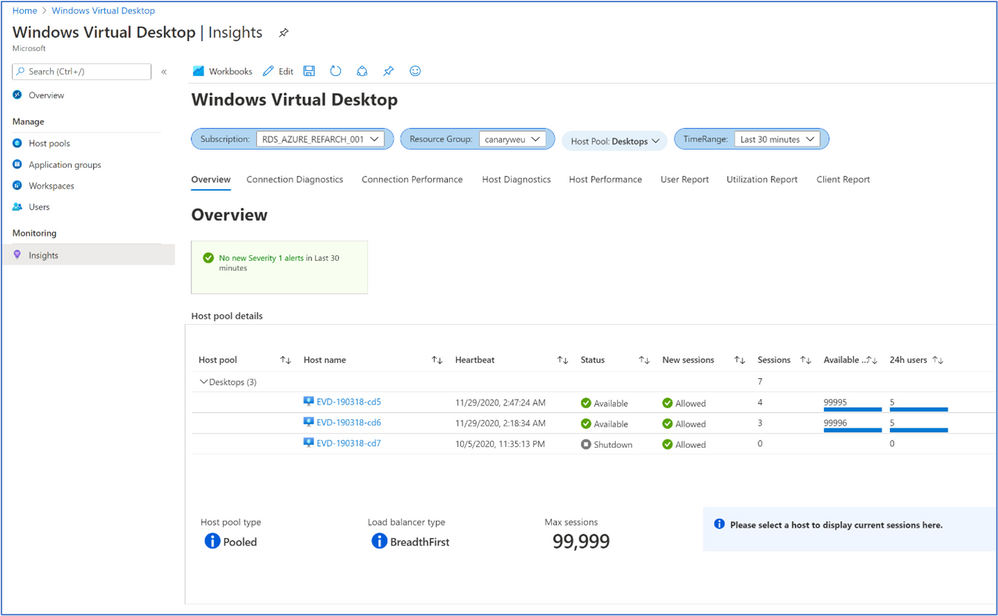
Screen Capture Protection
With the new Screen Capture Protection feature in public preview, customers can easily cake the creation of screenshots of the virtual desktop session. For case, if you want to protect all the data from going out of the consolidated virtual desktop session, this feature is definitely something you lot'd like to add together on top of your Conditional Access and Azure MFA rules to enhance the data protection level of your Desktops in the Cloud – every bit part of Azure Virtual Desktop. See below an example for information technology works, the desktop session that is completely black is where the Screen Capture Protection characteristic has been enabled. The feature also works when your desktop session is shared via Teams screen-sharing. Larn hither how to activate the feature on a Windows x Enterprise single or multi-session desktop.

Azure automation – auto-scaling tool
For many Azure Virtual Desktop deployments in Azure, the virtual auto costs of the Azure Virtual Desktop session host VM represent the most significant portion of the total deployment cost. To reduce cost, the AVDDepth-first way automatically fills upward the first session host server maximum corporeality of users before spinning up the next 1, so on. The other option is to use it to shuts downwards and de-allocates RDSH server VMs during off-height usage hours then restart them during pinnacle usage hours.This tin can exist a huge cost saver!
Breadth way is the standard – default mode, which is based on Reserved Azure instances (IaaS). With Breadth style, the users will spread across host puddle drove.
Read more virtually this feature, and download the new Azure Automation Runbook script for ARM-based AVD here.
Start VM on Connect
The word is saying information technology, with the new feature VM showtime on Connect – you can outset the session host while clicking on the icon. This is a huge cost saver as you could shut downwards your virtual machines while logging off and spin them up the mean solar day after.

This feature is only available for personal host pools and is NOW AVAILABLE in public preview. More information: Start virtual machine connect – Azure | Microsoft Docs
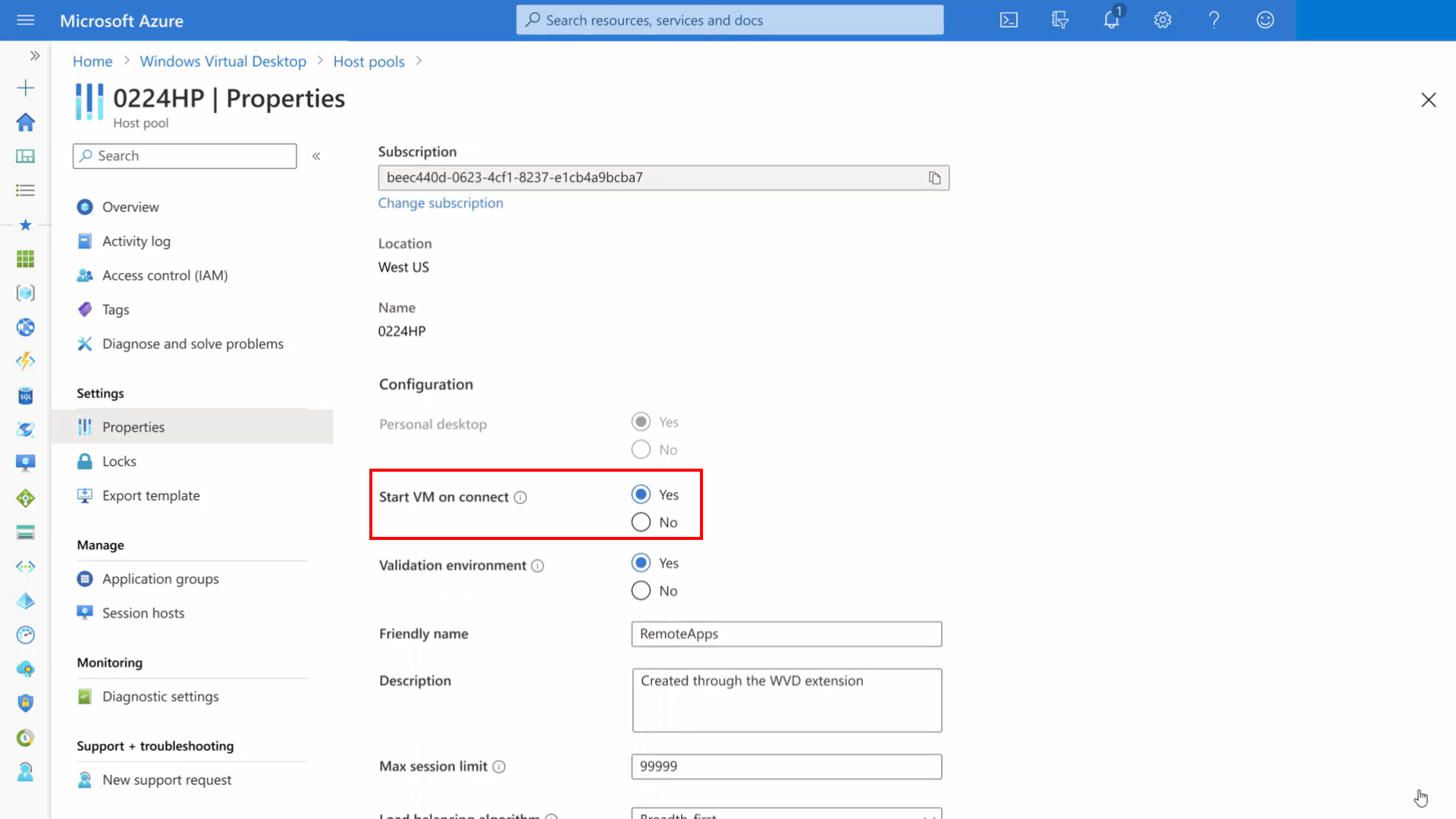
Once more – What is Azure Virtual Desktop?
People that follow my blogs know that I explained the services and benefits before. However, for the people who didn't catch that yet, here is a brusk run-over.
"Azure Virtual Desktop, or AVD in short – is a born in the cloud Managed-platform service offering on top of the Microsoft Azure Cloud. All the infrastructure services, such as brokering, web access, load-balancing, direction and monitoring is all setup for y'all equally function of the command aeroplane offer. It also gives you lot access to the new Windows 10 Enterprise multi-session Operating System – which is completely optimized for the sake of Office 365 ProPlus services, such as Outlook, OneDrive Files on Need (per-machine), Teams etc."
The only responsibility in terms of management effort is the golden images on tiptop of Azure Infrastructure-As-a-Service (IaaS). The rest is all managed for you through the Azure service SLAs. Sounds pretty cool, right?
Let's first outset with the things you might not know well-nigh information technology
- Azure Virtual Desktop gives you the just multi-session Windows 10 feel, including compatibility with Microsoft Shop and existing Windows line-of-business apps, while delivering cost advantages.
- Allows you lot to virtualize both Full desktops and RemoteApps.
- You tin can also use for persistent Windows ten – unmarried-user virtual desktops.
- AVD will support Windows 7 virtual desktops and is the merely way you lot tin can safely run Windows 7 subsequently its End of Life on 14 Jan 2020. Windows seven desktops on AVD volition be the But systems that receive free extended security updates.
- Customers with the post-obit license SKUs are entitled to employ AVD with no additional charge apart from Azure compute, storage, and network usage billing:
- To run Windows 10 multi-session, Windows x
- Microsoft 365 F1, E3, E5, A3, A5, Business organization
- Windows ten Enterprise E3, E5
- Windows 10 Education A3, A5
- Windows 10 VDA per user
- To run Windows vii
- Microsoft 365 E3, E5, A3, A5, F1, Business…Windows E3, E5, A3, A5
- To run Windows Server 2012 R2, 2016, 2019
- Remote Desktop Services (RDS) Client Admission License (CAL) with active Software Assurance (SA)
- To run Windows 10 multi-session, Windows x
- Azure Virtual Desktop session host VMs are not exposed to the net directly. They can run using a private IP address and run isolated from other workloads or even the internet. The reverse connect engineering science allows the VMs to be accessed
- When a user connects to the AVD service, the use of Azure Active Directory (AAD) as the identity provider allows yous to leverage additional security controls similar multifactor hallmark (MFA) or conditional admission;
- Deeply integrated with the security and management of Microsoft 365, such as Intune Modern Direction
- From a best practices indicate of view; Make certain all Azure resources are in the same region
- All the Nvidia vGPU / and the recently announced AMD Ballsy CPU/GPU graphical enhanced N-Series virtual machines on Azure are supported with Azure Virtual Desktop.
- Citrix is adding their own Citrix Deject stack every bit well to Azure Virtual Desktop, read more nearly this here.
- VMware Horizon Cloud is at present also available as an extension to Azure Virtual Desktop, read more about this here.
The compages backside it all
The first stride that you must do is creating the Azure Managed prototype, or gilt image in VDI terms (or use ane pre-build from the gallery). Almost oftentimes, this will be based on the new Windows 10 Enterprise multi-session Operating System, which is now available from the Azure Market place. Subsequently enrolling in the server, y'all tin can offset installing the awarding on the motorcar. When you're done, you lot must capture the car as an paradigm to use as a base of operations for your Azure Virtual Desktop deployment.
The Microsoft-managed command-plane is a completely redesigned infrastructure that leverages native Azure platform services to calibration automatically. Call back near Azure front end-door as a global load-balancer for the RDP connection, Azure App Services in Azure for hosting the infrastructure services, and Azure SQL DB for hosting the RDS Brokering databases. Leveraging these services is the main reason why this service is so cost-constructive, which is the purpose of the Cloud and what it's built for!
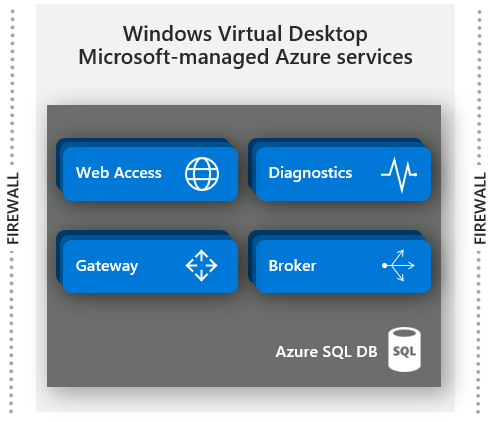
AVD User connectedness Traffic Period
To requite you a better understanding of how Azure Virtual Desktop connections piece of work, I'yard sharing the traffic flow (the traffic flow requires the post-obit network URL and protocol access). This is also useful for troubleshooting purposes.
Connecting from your virtual machine in Azure to your Host Pool (session hosts in Azure Infrastructure-Equally-a-Service) works differently with Azure Virtual Desktop. It uses Reverse Connect, which means that no entering ports need to be opened on the VM to setup the RDP connection. In one case the connection flow proceeds, bidirectional communication betwixt your session hosts/host pool volition go over port https (443). This port is almost always open from the inside to the outside, and so it's perfect for a remote connection to Azure Virtual Desktop!
Azure Virtual Desktop is a global load-balanced service via Azure front end-door. This ways that the traffic flow beneath always goes via the nearest management command-plane/service location – which you can encounter in the middle saucepan beneath.
The service is globally available with management aeroplane in:
Primal United states, Due east The states, Due west Usa 2, North Europe, West Europe, India, Singapore, Australia, Due south Africa, F rance, Germany, Norway, Uk, Korea , and Due south America. Available in GA.
Soon bachelor. To improve latency in other locations, the United Arabic Emirates — are beingness added soon. Please check our public roadmap hither.
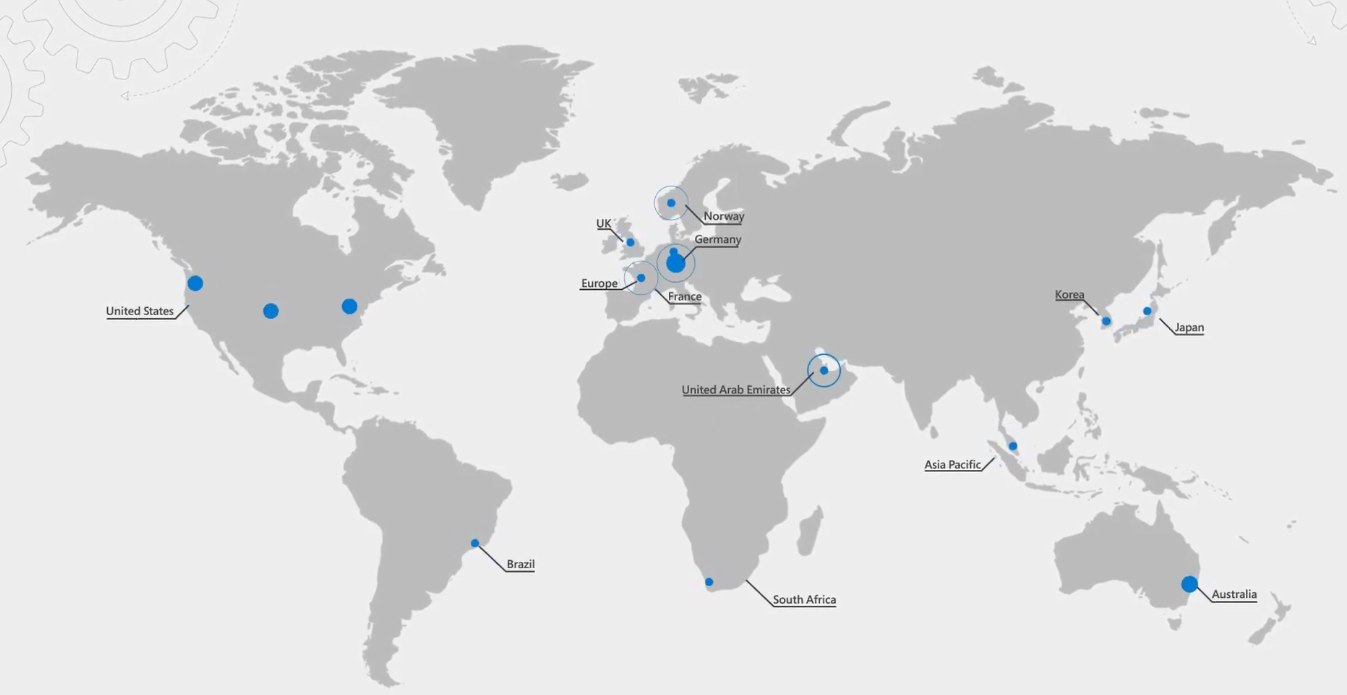 See below in more than depth how the traffic flow works.
See below in more than depth how the traffic flow works.
- User launches RD client which connects to Azure Advertizement, Azure MFA, user signs in, and Azure Ad returns token
- RD client presents token to Web Access, Broker queries DB to determine resource authorized for user
- User selects resource, RD client connects to Gateway
- Broker orchestrates connection from host amanuensis to Gateway
- RDP traffic now flows between RD customer and session host VM over connections three and 4

Azure Virtual Desktop service network admission requirements
To brand this traffic flow possible – you demand to have at least firewall rules / NSGs / service tags in place for the following network addresses – otherwise, AVD won't piece of work correctly. When you use an ExpressRoute with strength-tunnelling to your local gateway, make sure to configure the routing tables right, every bit described for KMS in this article. Inside configuring this – your virtual machines won't be able to communicate to our Azure KMS server. There'south as well the selection to employ Azure Service Tags with all the URLs/Ports pre-configured and auto-updated for y'all – this could brand your life a lot easier. Y'all can observe the full list of URLs hither too.
Note: If you don't accommodate access at the VNET level to the URLs/Ports below – your deployment most likely will fail!

To connect from the client – endpoint location. The post-obit network access is required to setup the session to the AVD service.
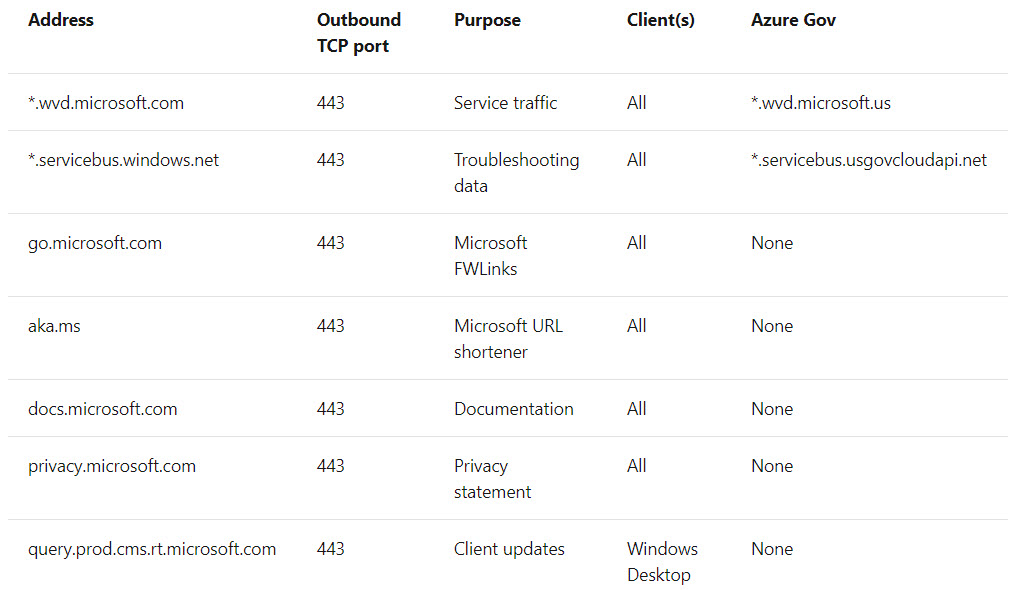
Measure your latency – tools
We tin can use the online Experience Reckoner tool to measure your latency to the nearest control-plane location (as described higher up) – without deploying a host pool. The tool is web-based and tin be found here. The tool measures to the nearest control-aeroplane the latency and as well from the control-plane to the (over the Azure backbone) Azure datacenter region you select to deploy your host pools in.

Another option is to use the latest AVD Windows Customer and request for the details of the connectedness. You tin request them by clicking on the bluish top-middle bar, click on the connection strength icon followed past connection details, and expand the details to see the screen below.
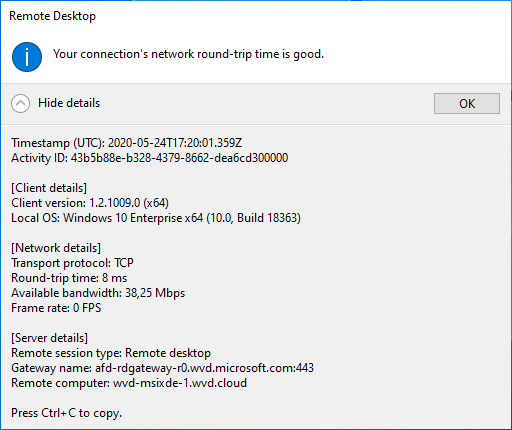
RDP Shortpath
RDP Shortpath is an addition to the RDP protocol to raise network traffic flow to take a shorter direct route to the session host from the user's physical endpoint location. Information technology doesn't supervene upon reverse connect but information technology builds on acme of it to ameliorate the catamenia and UX. Another huge do good is that the session (with RDP Shortpath enabled) doesn't rely on the gateway service anymore – whereof brokering is managed through the Azure Virtual Desktop infrastructure.
In order to utilize RDP Shortpath, yous must take a direct line of sight to the session host – from the physical endpoint via e.g. ExpressRoute, Site 2 Site, or any other VPN service. Enabling the service network addon is relatively uncomplicated, yous tin can discover the steps to do so over here.
Want to take a deep-dive on RDP Shortpath? Make sure to watch episode #9 about RDP Protocol improvements and RDP Shortpath deep-dive with Denis Gundarev, AVD PM.

Manage Windows 10 multi-session via Endpoint Manager (MECM)
Since Microsoft Endpoint Manager (MECM) version 2006 – it's possible to select Windows 10 Enterprise multi-session every bit a platform in the listing of supported OS versions on objects with requirement rules or applicability lists. Come across below the screenshot of the new option every bit a requirement for multi-session. Read more than nearly it here.
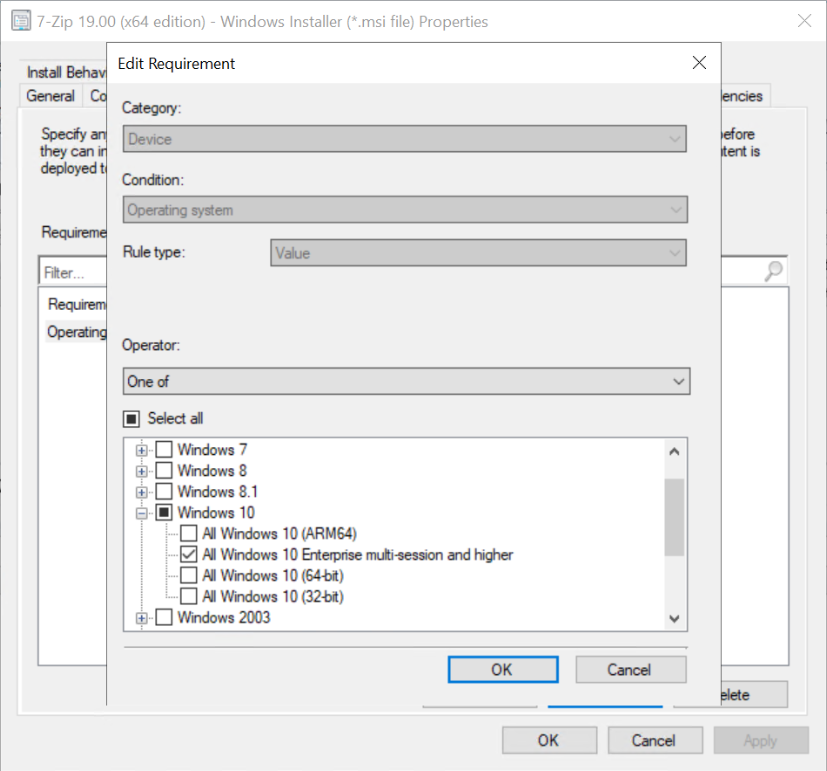
What well-nigh GPUs?
Azure Virtual Desktop – supports graphics dispatch, check out for more information Choose your graphics rendering technology. Azure has other graphics acceleration deployment options and multiple available GPU VM sizes. Learn about these at GPU optimized virtual machines sizes – particularly the new Nv4 virtual machines enhanced by a AMD EPIC CPU/GPU are interesting to test due to the fact it supports GPU-P and Premium SSD.More than info hither.
Talking about GPU and intense workloads? Watch this not bad episode almost pushing the operation boundaries of your Azure Virtual Desktop environment.
Azure Virtual Desktop – ARM-based portal enrolment process
In the next steps, I'll explain how you enrol Azure Virtual Desktop from scratch with a customer created Windows 10 Enterprise multi-session image among tips and tricks.
Pre-requisites for Azure Virtual Desktop
The following requirements are needed for the use of Azure Virtual Desktop on Azure.
- Azure Subscription
- Azure Active Directory setup
- Azure Advertizing Connect
- Entitled for licensing
- Admin permission to enable resource provider on subscription
- Admin with privilege to create VMs
- (optional) custom image
- Domain controller
- This AD must exist in sync with Azure AD so users tin can be associated between the two
- VMs must domain-bring together to Active Directory
- Optional: Azure Advertizing Domain Services (in replacement for domain controller)
- Profile Containers network share on Azure Files or Azure NetApp Files (Run into hither our recommended Azure Managed options)
- VNET pre-created with connexion to the domain
- Network must route to a Windows Server Active…Directory (AD). Meet here all the required ports and URLs. – same for the endpoints/customer access, observe them here.
- Optional: Networking/on-prem connectivity – express route, VPN, etc.
Create a custom Windows 10 multi-session image
Note: You can skip this step and start here if you want to utilise a Microsoft prepared epitome with Windows 10 multi-session + Microsoft 365 Apps for Enterprise.
We stfine art with the creation of a custom Azure Managed image (right at present based on Windows x Enterprise multi-session, nevertheless Windows vii and Server 2012 R2 and higher is supported as well). This image can be used during the new Azure Portal enrolment procedure to brand sure all our new session hosts based on Windows ten Enterprise multi-session includes all our agents and corporate applications.
During this enrolment we go through different the range of layers, including applications, incorporating language components, and tailoring organization settings to adhere to Azure recommendations – to effectively make information technology client and end-user ready. Let's beginning.
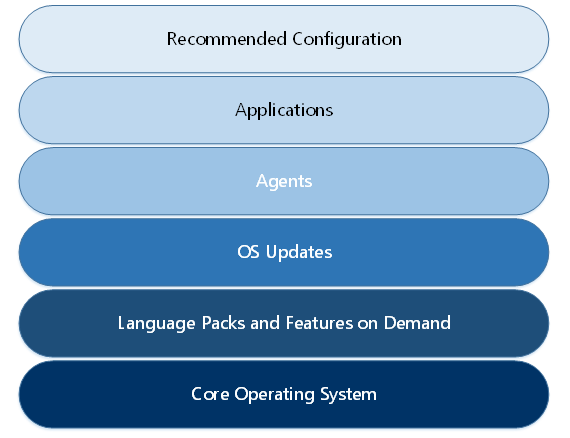
Nosotros start with the cosmos of a custom Azure Managed image(right at present based on Windows ten – multi-session, however Windows vii and Server 2012 R2 and higher is supported too). This image tin can be used during the new Azure Portal enrolment process to make sure all our new session hosts based on Windows 10 Enterprise multi-session include all our agents and corporate applications.
Note: When you want to use a prepared (East.chiliad. Windows x multi-session + Office 365 ProPlus) prototype from the Azure Gallery – please skip these steps and continue here.
Note: The new ARM templates for Azure Virtual Desktop ARM-based are now available for download here.
Go to Virtual Machine
Click on + Add together
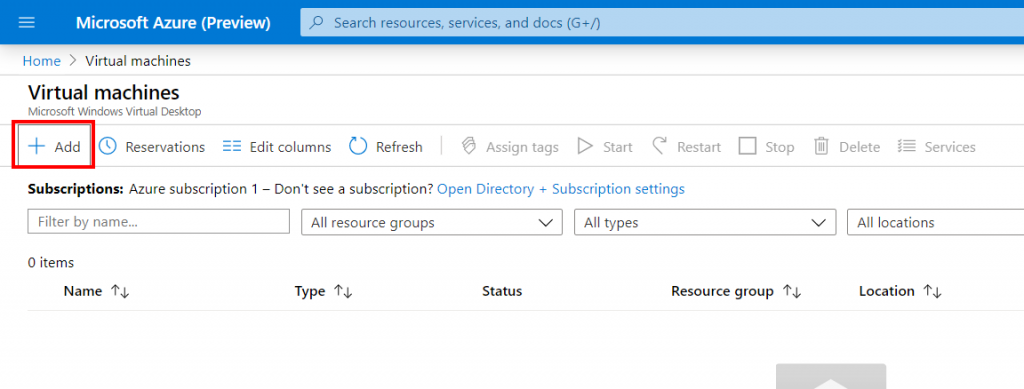
Click on Browse all images
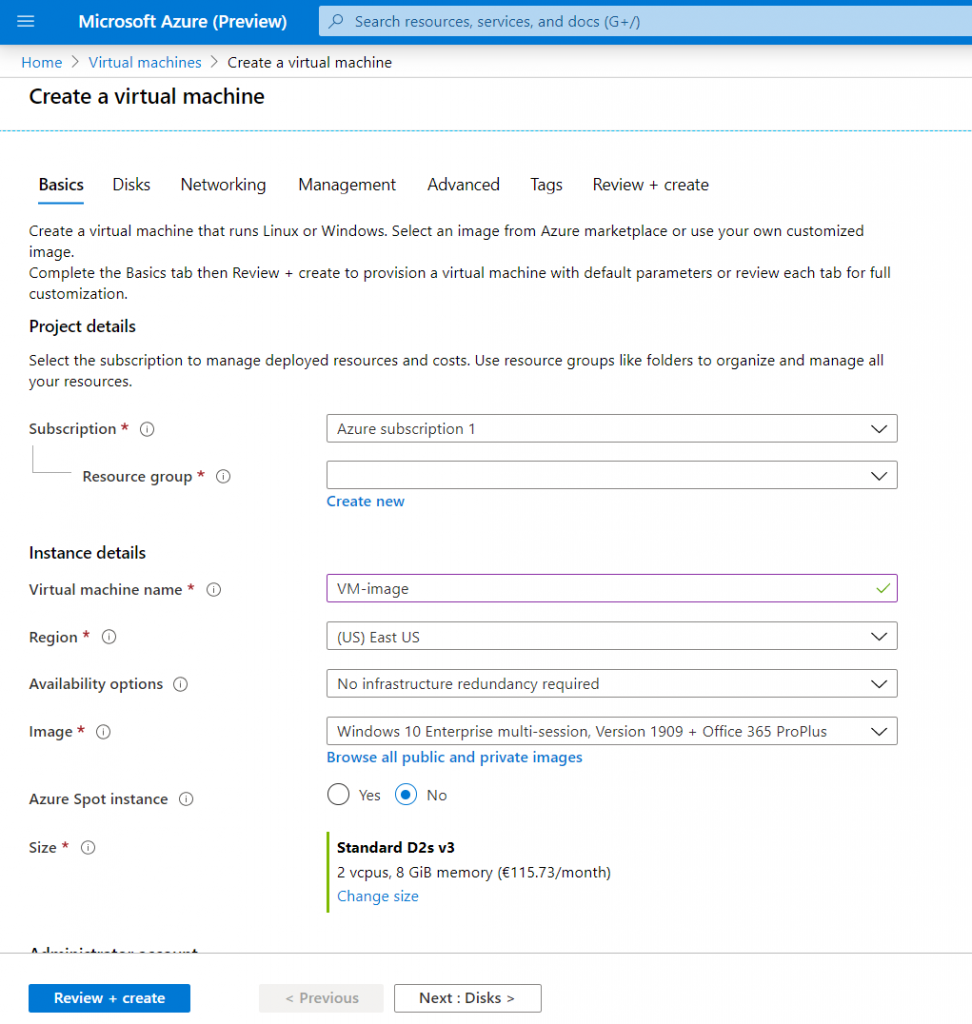
Southward elect Windows ten Enterprise multi-session + Office 365 ProPlus
Note: Office 365 ProPlus has been renamed to Microsoft 365 Apps for Enterprise.
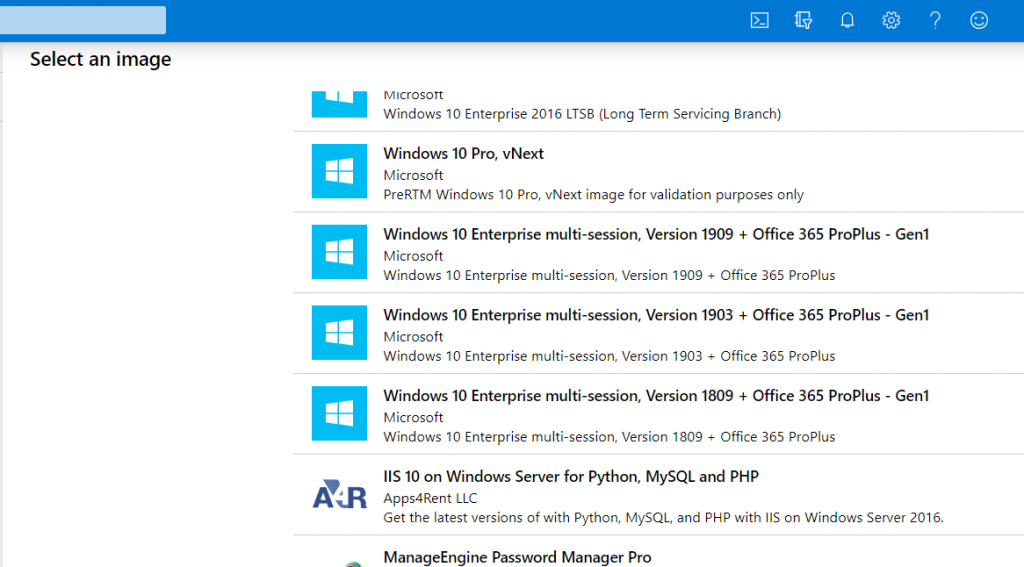
In one case the virtual machine is enrolled and upwardly and running:
Connect – your VM-Image – through Azure Bastion – or RDP to the machine – this tin be internally or externally.
Once you are logged on to your principal image. Now we can add together our agents to the image, such as the FSLogix Apps Agent, plus your own agents and line of business (LOB) – applications.
Install OneDrive Per-Car
Past default, the OneDrive sync customer installs per user on Windows, meaning OneDrive.exe needs to be installed for each user account on the PC nether the %localappdata% folder. With the new per-machine installation choice, you tin install OneDrive under the "Plan Files (x86)" directory, meaning all profiles on the calculator will employ the same OneDrive.exe binary.
You tin download the new per-machine version of OneDrive below:
https://go.microsoft.com/fwlink/?linkid=2083517
Make sure to re-install the application past using the following command.
OneDriveSetup.exe /allusers
As well, when running this on a multi-session environment, this means that on that aforementioned session host, all the different user-contour – OneDrive versions volition update simultaneously – which can become messy in terms of network throughput. This is also solved with the per-motorcar version.
The per-machine version will update itself by a service/account which injects itself during the installation. Therefore, you always need to run the installation as local administrator with UAC privileges.
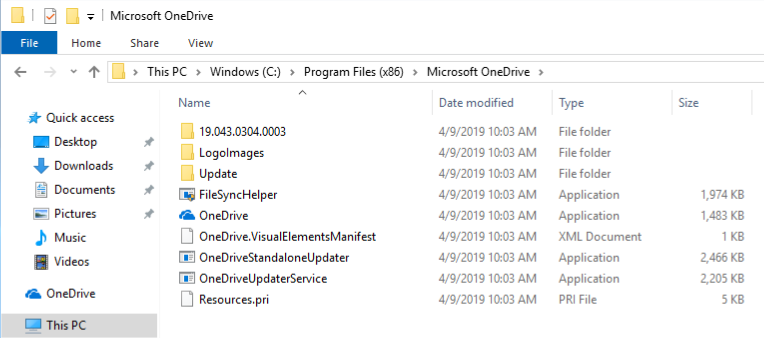
OneDrive Known Folder Move – modernize your profile
Recently, the OneDrive squad added Known Folder Move functionality support to OneDrive, which is very useful to create the same finish-user experience for our users on Azure Virtual Desktop equally they would accept on a Modern Desktop with all profile folders, such every bit My Documents, Pictures, Favorites, Desktop, etc. redirected to OneDrive. Also, with the utilize of OneDrive Files On-Demand, you'll be able to save storage space from your profile folders due to the possibility to piece of work with tiering for your hot and cold information.
While using Known Folder Motion on different devices or VDI environments in conjunction with the aforementioned OneDrive account. You lot ensure to ever take your Office 365 documents on the same location, everywhere yous go! Even on your mobile device, without any notice 😊
Activating Kown Folder Motility is relatively easy. Yous tin utilise the manual approach by opening the OneDrive client from the Start card and click on Update Folders.

You can also use the automated approach
Enabling this policy sets the following registry keys:
[HKLM\SOFTWARE\Policies\Microsoft\OneDrive]"KFMSilentOptIn"="1111-2222-3333-4444"
(where "1111-2222-3333-4444" is the AzureAD Directory – tenant ID, which you can find in the Azure Portal – nether the properties menu of your Azure AD tenant)
In the end, your profile folders volition expect like this, and are completely in sync with your OneDrive account.

Install Teams with AV Redirection media optimizations
Skillful news, the long-awaited new AV Redirection with media optimization (WebRTC) client for Microsoft Teams is at present bachelor for the Windows Desktop on Windows x machines.
Cardinal benefits of this new Teams WebRTC optimizations are:
- High-performance peer-to-peer streaming facilitated by WebRTC – as listed below traffic will flow p2p and rendered via the endpoint
- Devices will be redirected as same hardware device – better hardware redirection support
- On Windows x clients, all the benefits of the mod media stack including HW video decoding
- Support for Windows 10 single and multi-session in conjunction with Azure Virtual Desktop.
Note: Media optimizations require Windows Desktop client version i.two.1026.0 or later on – running on Windows ten as endpoint Operating Organization. Also, Brand sure to optimize your traffic for Teams in general for the use of this client.
First we must create the post-obit registry k ey in the prototype
HKEY_LOCAL_MACHINE\SOFTWARE\Microsoft\Teams\
Name: IsWVDEnvironment
Blazon: REG_DWORD
Value: 1
Download Teams and run the command below to install Teams per-machine
Note: To use the WebRTC AV redirection customer, you lot must use Teams version i.three.00.4461 or later – the 64-flake version is highly recommended.
- 64-bit version (recommended)
- 32-bit version
msiexec /i c:/install/Teams_windows.msi /50*5 < c:/install/Teams.log ALLUSERS=ane ALLUSER=ane
If everything ran perfect y'all will see Teams showing upwardly in the Programme Files directory.
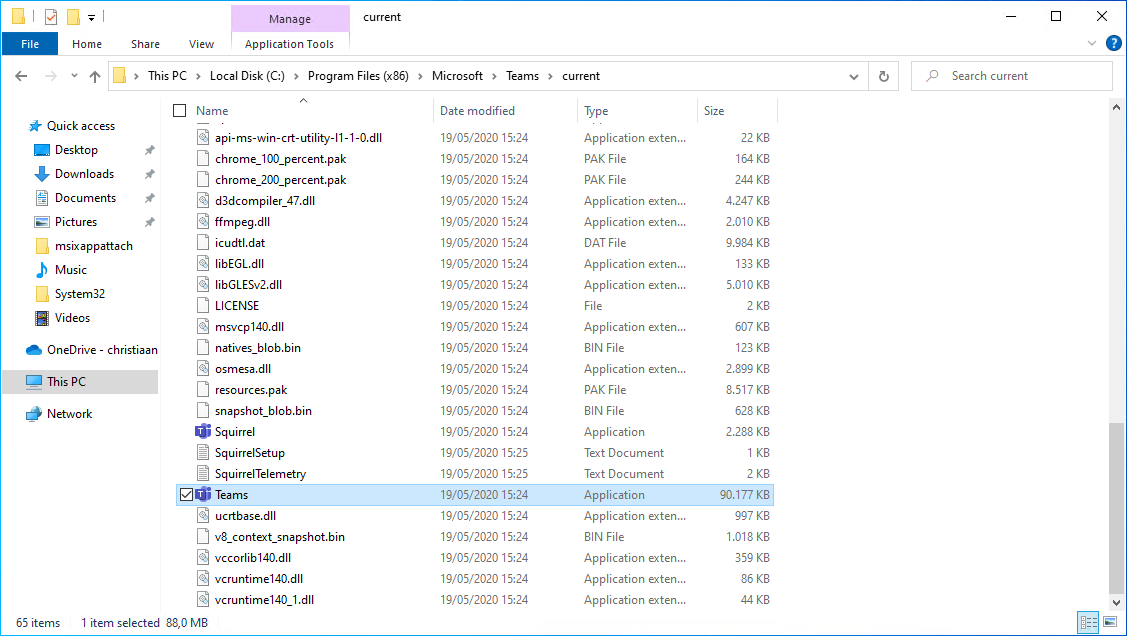
Install the WebRTC – Teams WebSocket Optimizations client in your AVD image
Note: When you run into installation issues, please make sure to install the latest Microsoft Visual C++ Redistributable below and endeavour the WebRTC installation once again.
- Microsoft Visual C++ Redistributable x64: vc_redist.x64.exe
- Microsoft Visual C++ Redistributable x86: vc_redist.x86.exe
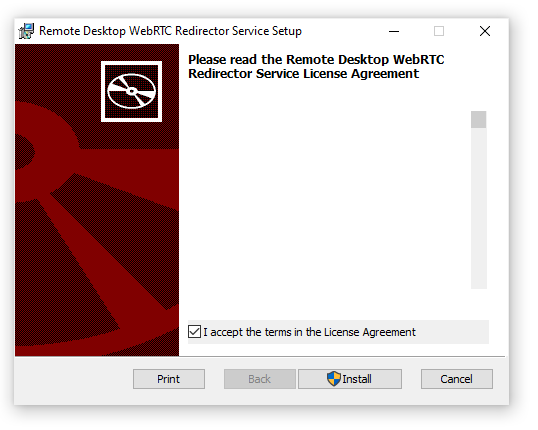
When everything goes as expected. Delight start Teams – go to the About settings of your Teams Customer inside your session host.
Please become to this docs article if you meet whatever bug regarding the public preview.
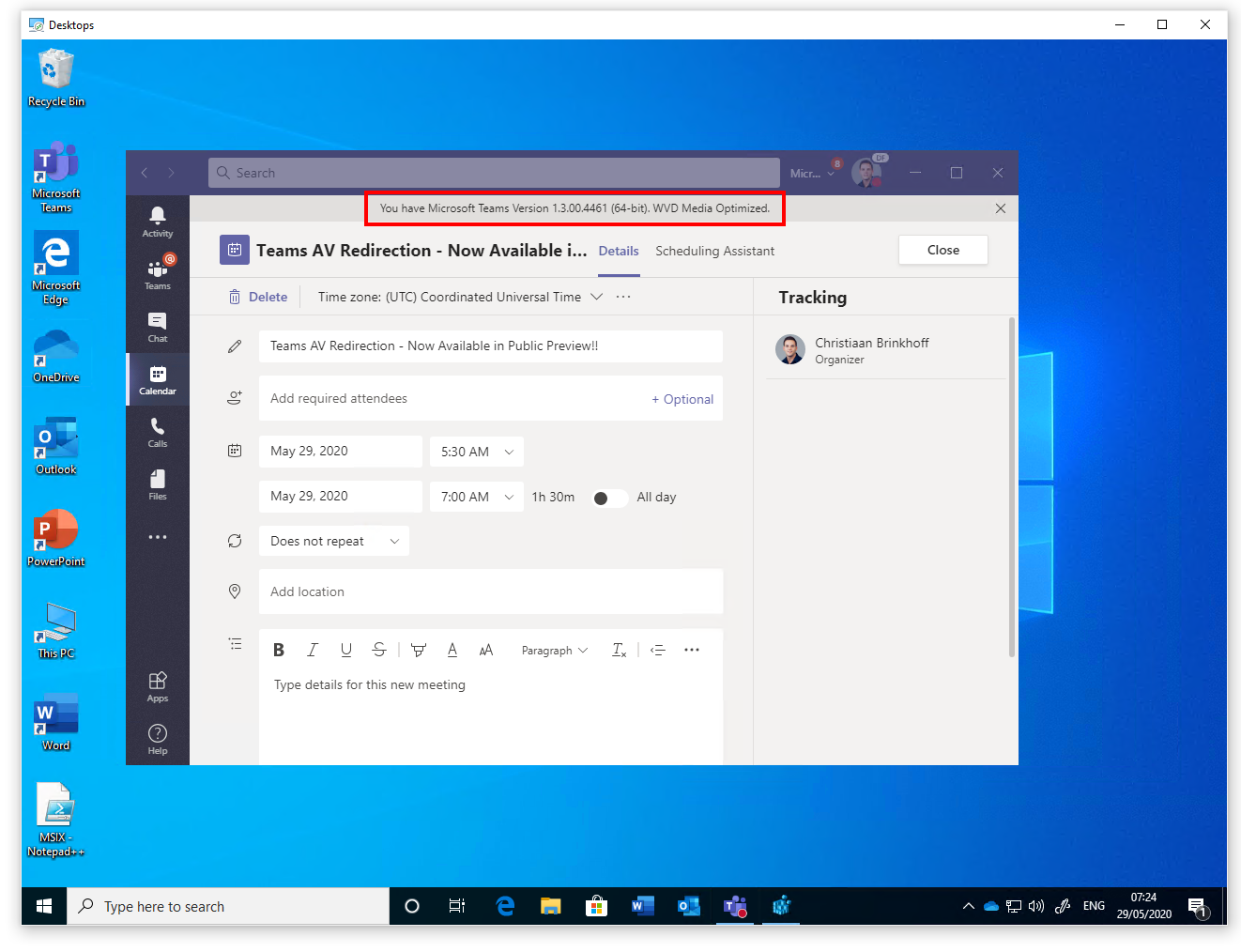
Add together fifty anguage packs
Brand sure to post-obit the steps in this commodity to add together additional languages to the Azure Managed Image.
https://docs.microsoft.com/en-us/azure/virtual-desktop/language-packs

Add FSLogix Contour Container equally a profile delivery solution
Annotation: If you are interested in how you lot could Azure Files or Azure NetApp Files inside AVD. Please consider one of the ii articles below in improver to this blog. You can find ALL the differences betwixt the two options here.
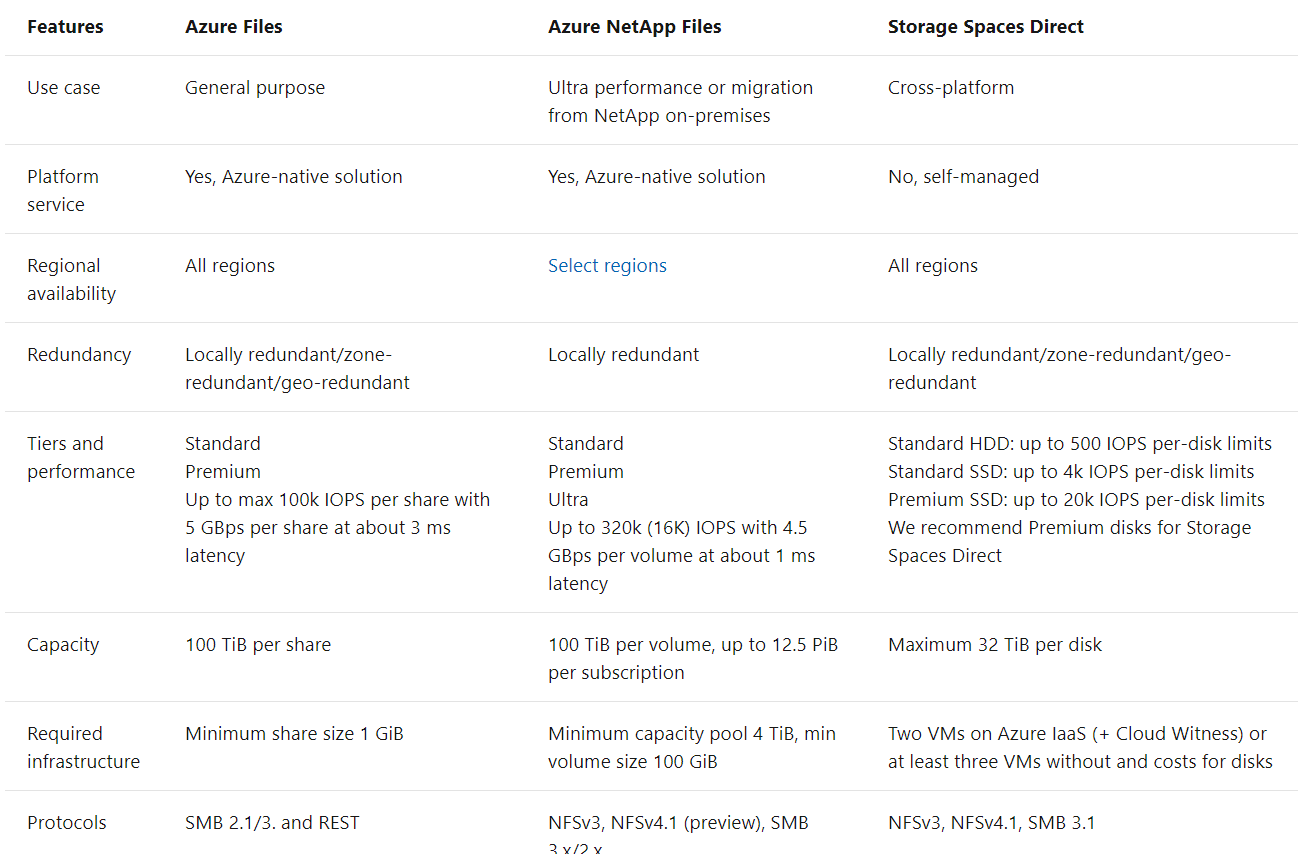
In general IOPS between 5 and fifteen (depending on workload/corporeality of Office 365 applications) per user'due south FSLogix Profile Container, with ~10x during sign in and sign out is adequate to utilize as a rule of thumb – preferred below the 5 ms (the lower the better).
- Getting started with FSLogix profile containers on Azure Files in Azure Virtual Desktop
- Create an FSLogix profile container for a host pool using Azure NetApp files
Download the FSLogix agent and install it in your Azure Virtual Desktop image – virtual machine. FSLogix is bachelor for download here

Install the FSLogixAppsSetup agent in the image
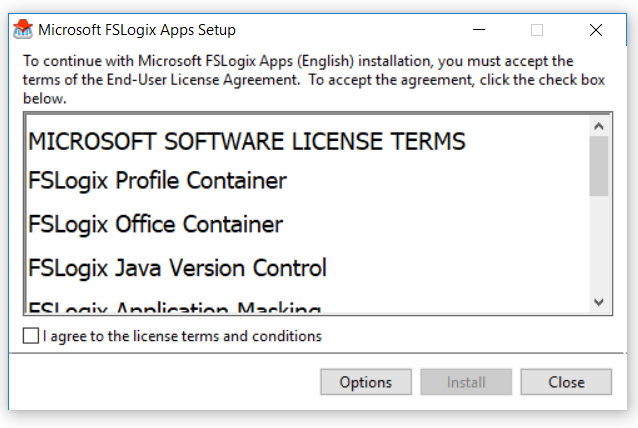
Wait for the installation to exist finished…
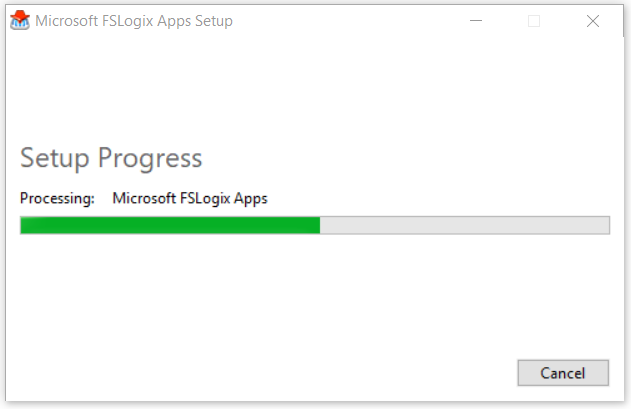
The configuration office of FSLogix Profile Container tin can be performed in either registry settings or group policy files. The well-nigh simple and effective method is using the registry settings below.
Open regedit.exe and browse to "HKEY_LOCAL_MACHINE\Software\FSLogix\Profiles"
Create a REG_SZ value proper name "VHDLocations" and enter new Azure Files network file share path (east.yard. \\fslogixwvddemo.file.core.windows.internet\fslogixprofiles)
Create a DWORD value name "Enabled" and give it value 1.
Create a DWORD value name "DeleteLocalProfileWhenVHDShouldApply" and give it value i. The one deletes existing local profiles before logon – this avoids errors.
Create a DWORD value proper name "FlipFlopProfileDirectoryName" and give it value 1. The one changes the folder proper noun to USERNAME-SID which is much easier during troubleshooting or maintenance search-related work.
Tip : The virtually of import settings for the usage of FSLogix Contour Container are the Enabled and VHDLocations registry setting. At that place are some other settings that I default recommend to enable. The VolumeTypesetting changes to disk type to VHDX. Y'all can provide more maintenance tasks via PowerShell with VHDx and so I advise changing that from default VHD to VHDx.
Notation : If you are using Windows 10 Enterprise single and multi-session or Windows Server 2019, you don't take to enable the RoamSearch setting. The Search DB is already stored in your user profile.
See here all the other advanced registry settings for FSLogix Profile Container. The instance below is with Azure Files.
Looking for more than best practices, please visit our new Azure Solutions Center page on – FSLogix for Enterprises hither.

Make sure to configure the following Antivirus exclusions for FSLogix Profile Container.
- Exclude Files:
- %ProgramFiles%\FSLogix\Apps\frxdrv.sys
- %ProgramFiles%\FSLogix\Apps\frxdrvvt.sys
- %ProgramFiles%\FSLogix\Apps\frxccd.sys
- %TEMP%\*.VHD
- %TEMP%\*.VHDX
- %Windir%\TEMP\*.VHD
- %Windir%\TEMP\*.VHDX
- \\server\share\*\*.VHD
- \\server\share\*\*.VHDX
- Exclude Processes
- %ProgramFiles%\FSLogix\Apps\frxccd.exe
- %ProgramFiles%\FSLogix\Apps\frxccds.exe
- %ProgramFiles%\FSLogix\Apps\frxsvc.exe
Enable the Screen Capture Protection feature
To enable the Screen Capture Protection feature, which I'm explaining here – you only have to run the command beneath to add the designated registry key to enable the characteristic – in your image. More info can be found here on Microsoft Docs.
Note: The feature currently only works for total desktop sessions from Windows 10 endpoints, Windows Desktop client, version 1.2.1526 or later is needed and your session hosts – host pool should be agile in the validation environs.
reg add "HKLM\SOFTWARE\Policies\Microsoft\Windows NT\Terminal Services" /v fEnableScreenCaptureProtection /t REG_DWORD /d i

Additional prototype optimizations
Run the following PowerShell commands to optimize the images based on the recommendations here.
Disable auto-updates
reg add "HKLM\SOFTWARE\Policies\Microsoft\Windows\WindowsUpdate\AU" /5 NoAutoUpdate /t REG_DWORD /d one /f
Time zone redirection
reg add "HKLM\SOFTWARE\Policies\Microsoft\Windows NT\Terminal Services" /v fEnableTimeZoneRedirection /t REG_DWORD /d one /f
Disable Storage Sense
reg add "HKCU\Software\Microsoft\Windows\CurrentVersion\StorageSense\Parameters\StoragePolicy" /five 01 /t REG_DWORD /d 0 /f
Finalize (sysprep) the Windows 10 multi-session prototype
Sysprep (Generalize) your image and shut down the virtual auto.
Note: You tin likewise perform this activity directly from the Azure portal – during the Managed image capturing process.
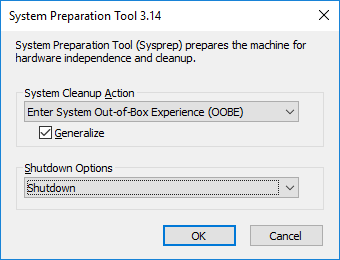
To wrap the Windows 10 Enterprise multi-session prototype up and start the host pool enrolment process from the Azure Marketplace, we must close down the virtual motorcar to release the prototype.
Capture the custom – Azure Managed – image
Create an Azure managed (custom) image from the VM in the Azure portal. Click on Capture
Note : The benefits of using an Azure Managed Image is that everything that you install volition be used as the baseline for the enrolment later on during the Azure Marketplace procedure. All the virtual machines you select to enrol will include all the same software as you at present install. For 500 virtual machines that save a lot of post-installation work. Of course, you can use your ain automation solution and build images from scratch and add your software afterward (post-installation) – it's all up to you!
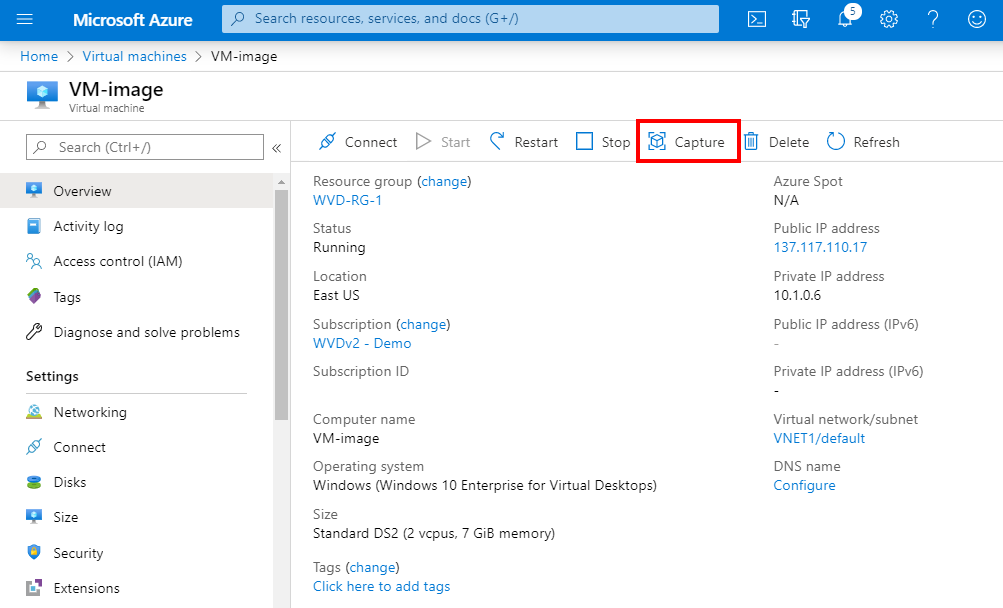
Create the paradigm. Enter theNameandResource group.You tin can provide your own versioning in the proper noun.
Notation: If the enrolment fails based om the Managed Image your created, information technology could exist that the VM on Azure didn't selection up the Generalized status on the VM level. Yous tin can force this past running the PowerShell command below.
Ready-AzVm -ResourceGroupName $rgName -Proper name $vmName -Generalized
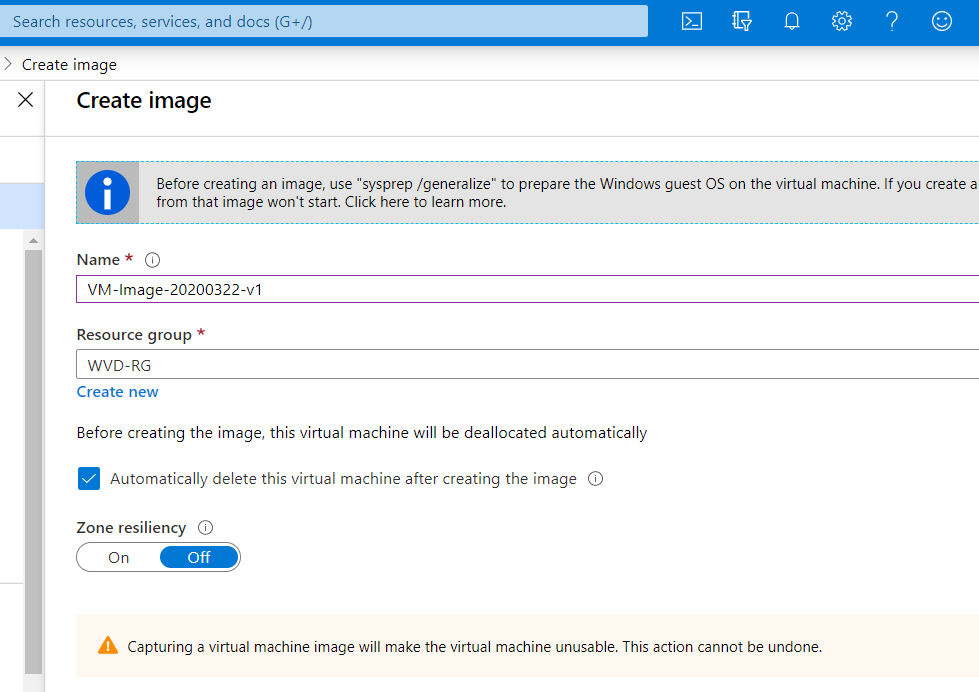
Update 20.11.2020. You lot can at present direct consign the captured image also into the Azure Shared Paradigm Gallery (SIG), as part of the recent improvements of the service. You tin read more about it here, it looks amazing and removes a lot of pre-steps in this article to create the shared image gallery separately.

Optimize your images with the Virtual Desktop Optimization tool
The virtual desktop optimization tool makes it possible to disable uncommon services for virtual desktop environments, such as Azure Virtual Desktop. Read this article to learn more than about the (Windows) Virtual Desktop Optimization tool.
Note : We recommend running the script below after the sysprep process. Most probable every bit a startup script while you have to deal with a large gear up of virtual machines.
Download all the scripts from the public Github repository below
Click on Clone or Download followed by Download ZIP.
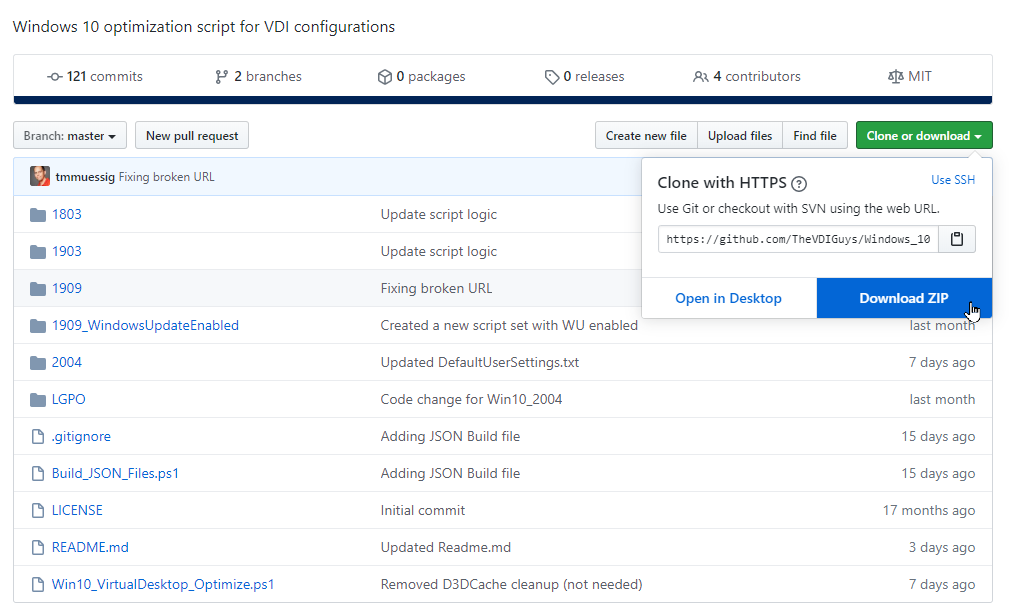
Unzip the binder to your Azure Virtual Desktop – session host (s) – in a random binder (ex. C:\Optimize or C:\Temp).
Notation : You could besides run the scripts as part of your image management procedure e.g. Azure paradigm Builder (AIB) or Azure DevOps if you like.
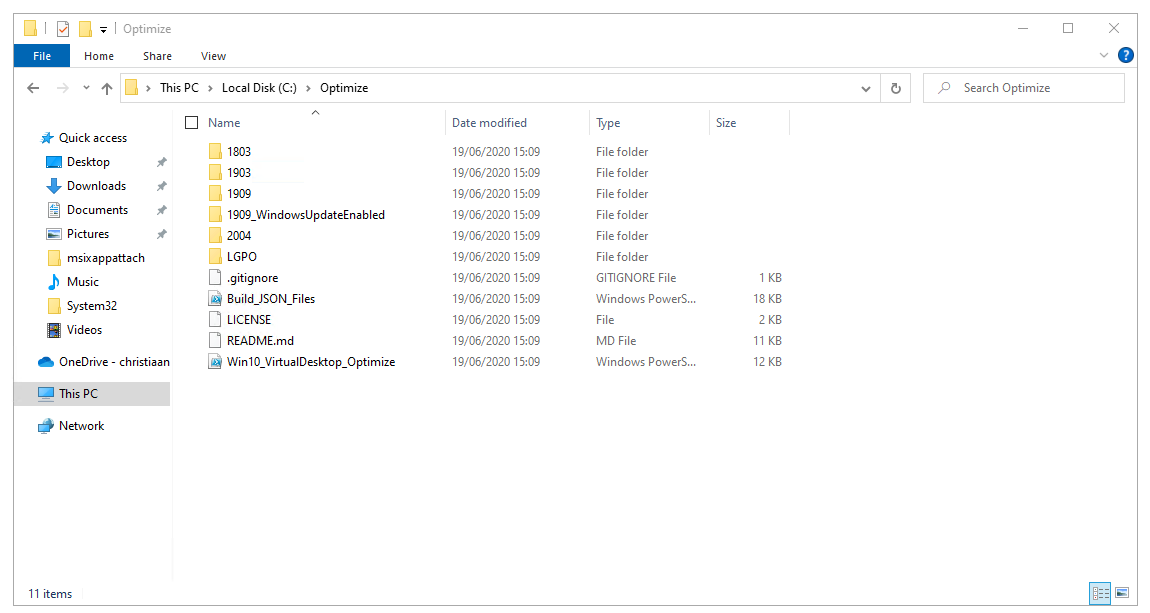
Of import data before you start running the tool
There are settings default disabled when you run the scrip out of the box such as AppX Packages for the Windows Calculator. We strongly suggest analyzing the tool via the JSON files that include the default settings. This likewise gives y'all the opportunity to enable them before running the tool so they remain untouched.
Yous can detect the JSON file in the Windows built number folder, under ConfigurationFiles – east.g. C:\Optimize\2004\ConfigurationFiles.
You've to put the settings to Enabled – that you want to go along every bit default. Beneath is the example file for AppX Packages, at that place are JSON files for Services and scheduled tasks as well.
Another option is to remove the whole entry out of the JSON file.
AppxPackages.JSON – Example Windows Computer App
{
"AppxPackage": "Microsoft.WindowsCalculator",
"VDIState": "Enabled",
"URL": "https://www.microsoft.com/eastward…",
"Description": "Microsoft Calculator app"
},
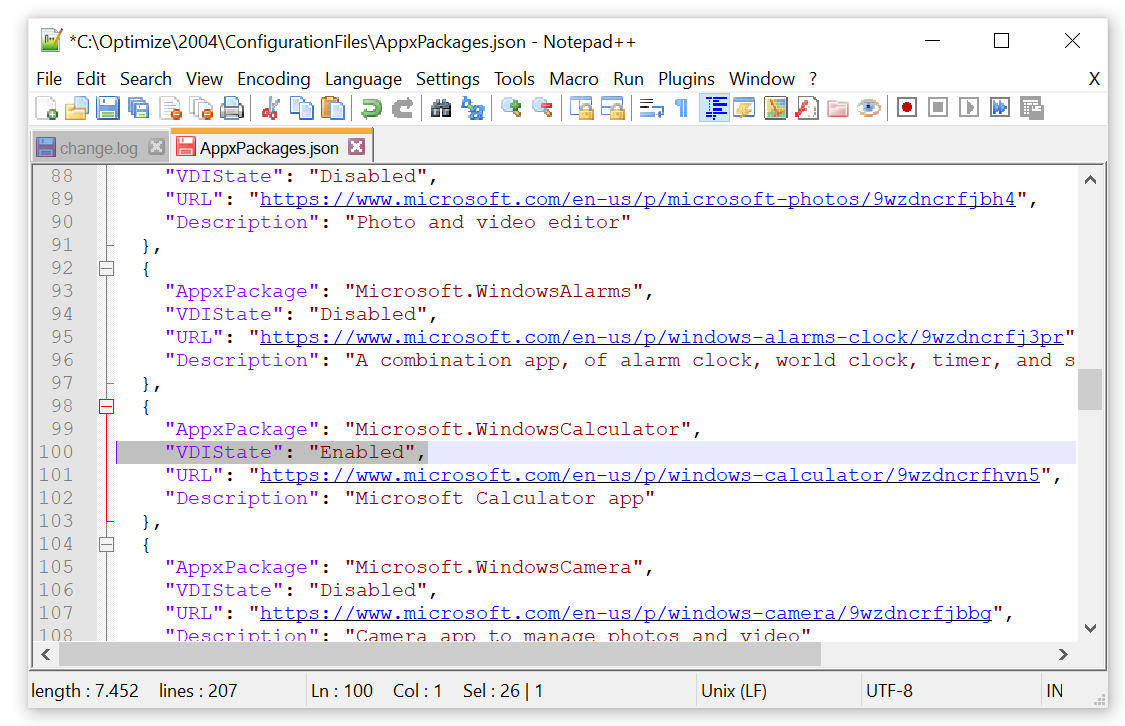
Services.JSON – example Windows Update Service
{
"Name": "UsoSvc",
"VDIState": " Enabled ",
"Description": "Update Orchestrator service, manages Windows Updates. If stopped, your devices will non exist able to download and install the latest updates."
},

Start PowerShell – Run as Ambassador
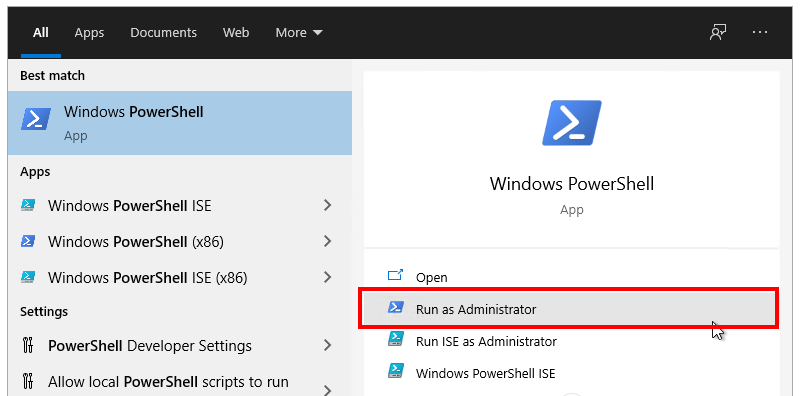
In PowerShell, alter directory to the scripts folder (due east.one thousand. C:\Optimize or your own specific folder)
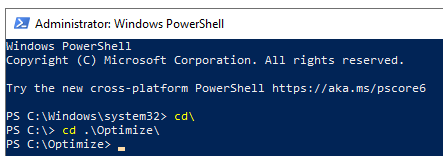
Run the following control to make running possible
Set-ExecutionPolicy -ExecutionPolicy Bypass

Run the VirtualDesktopOptimizationTool steps – past running the command below.
.\Win10_VirtualDesktop_Optimize.ps1 -WindowsVersion 2004 -Verbose
Note : When y'all use a unlike build of Windows 10, y'all must change the WindowsVersion parameter. Build 1803 and upwards are supported too for Windows 10 Enterprise. Windows ten multi-session support applies merely to build 2004.
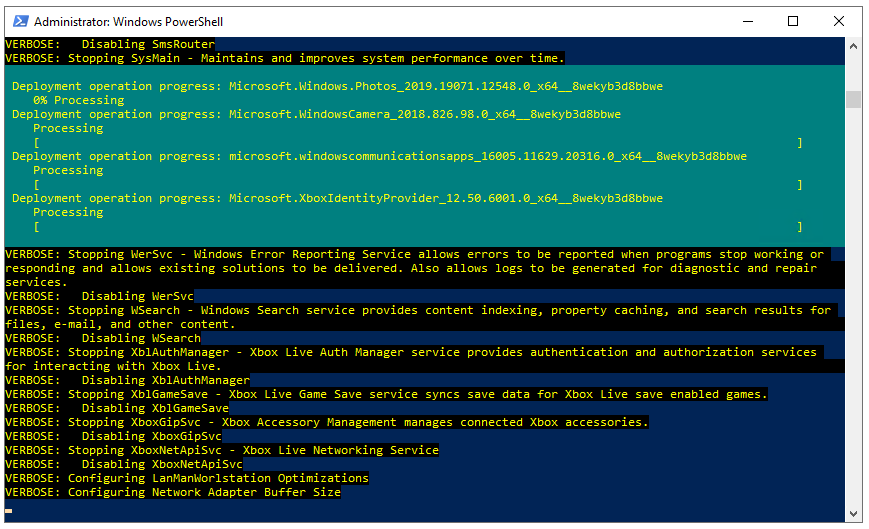
When complete, you should see a prompt to restart.
Reboot the session hosts(s)
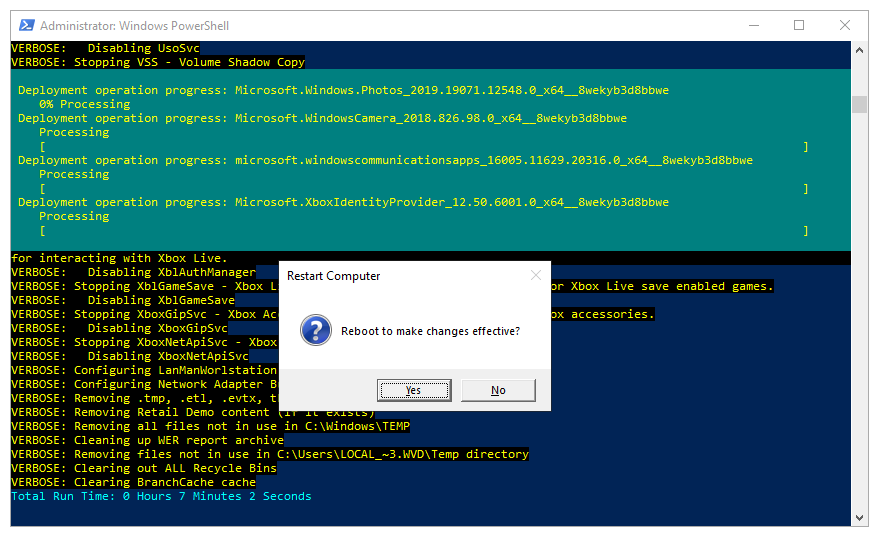
Do yous have any feedback – or questions about the optimization tool above? Delight use our Tech Community platform here to ask questions.
We recently had the creators of the Virtual Desktop Optimization tool as guests on our Desktops in the Deject video-podcast. Robert and Tim explained everything you should know, equally well as all-time practices and lessons learned. A must lookout man in extension to this commodity. Watch it beneath.
Create an Azure Shared Image Gallery (SIG)
Note: The pace below is optional. You lot could deploy a host pool based on an Azure managed image (simply) besides.
You as well have the option to use the Azure Shared Image Gallery (SIG) within Azure Virtual Desktop every bit a source for your images. You can share your images to different users, service principals, or Advertising groups inside your organization. Shared images can exist replicated to multiple regions, for quicker scaling of your deployments. Read more about it here.
- Managed global replication of images.
- Versioning and grouping of images for easier management.
- Highly available images with Zone Redundant Storage (ZRS) accounts in regions that back up Availability Zones. ZRS offers better resilience confronting zonal failures.
- Sharing beyond subscriptions, and even between Agile Directory (AD) tenants, using RBAC.
- Scaling your deployments with image replicas in each region.
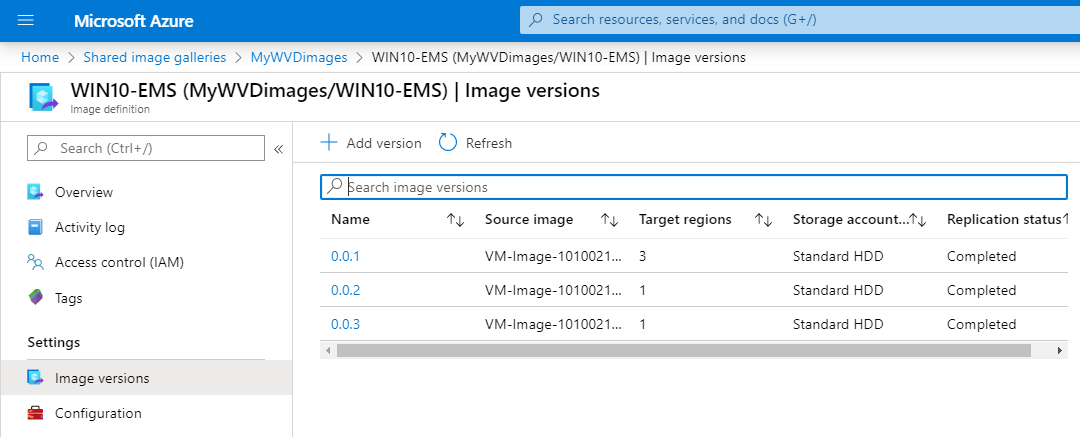
Boosted tips and tricks . If you are not aware of Azure Image Architect, please have a expect hither . I as well recommend to watch this Ignite session . The procedure works pretty uncomplicated and could simplify how you practice update and image management today as yous can hands create new images based out our Azure Marketplace gallery which receives all the latest updates directly after patch Tuesday. In this (beneath steps) article we apply the transmission arroyo via the Azure Managed image creation process.
More info on automation scripts for FSLogix and templates for AIB can be found here: https://aka.ms/azvmimagebuildertesting .
Let's start the creation of the shared image out of a Azure Managed Image
Look for Shared image galleries in the Azure menu

Click on Add together
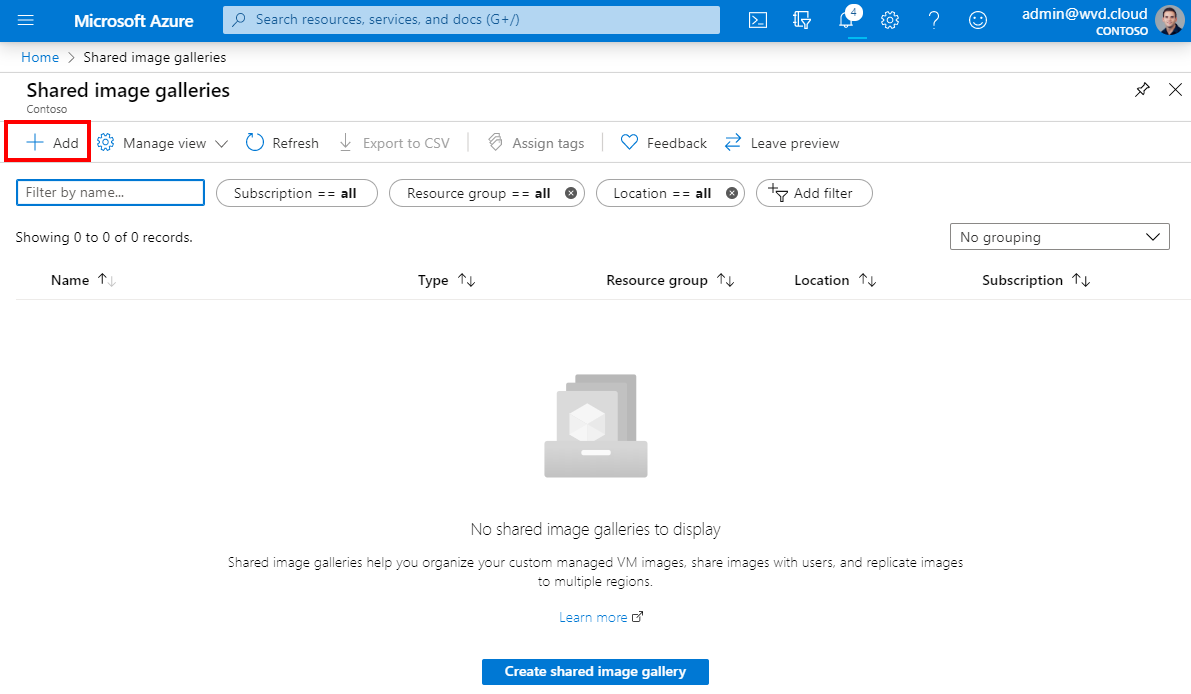
Create the Gallery
Click on Review + create
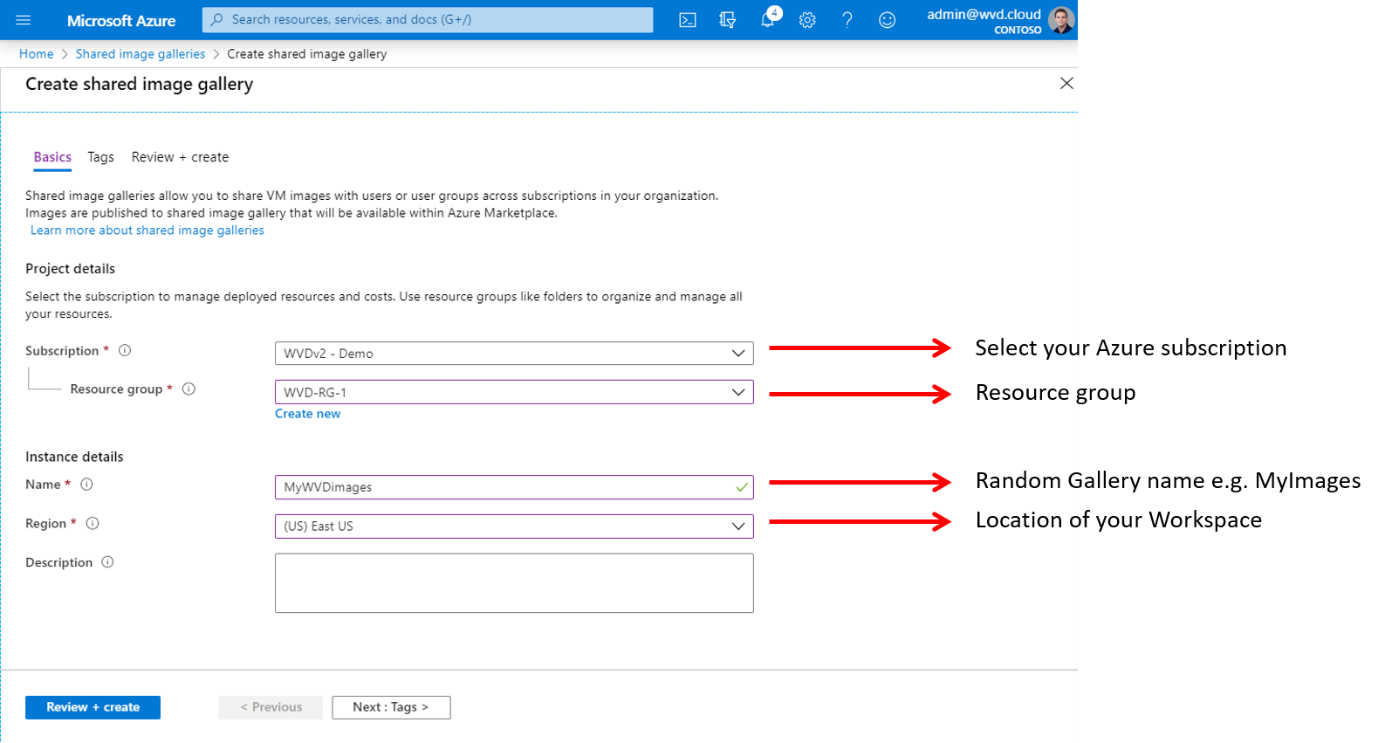
Click on Create
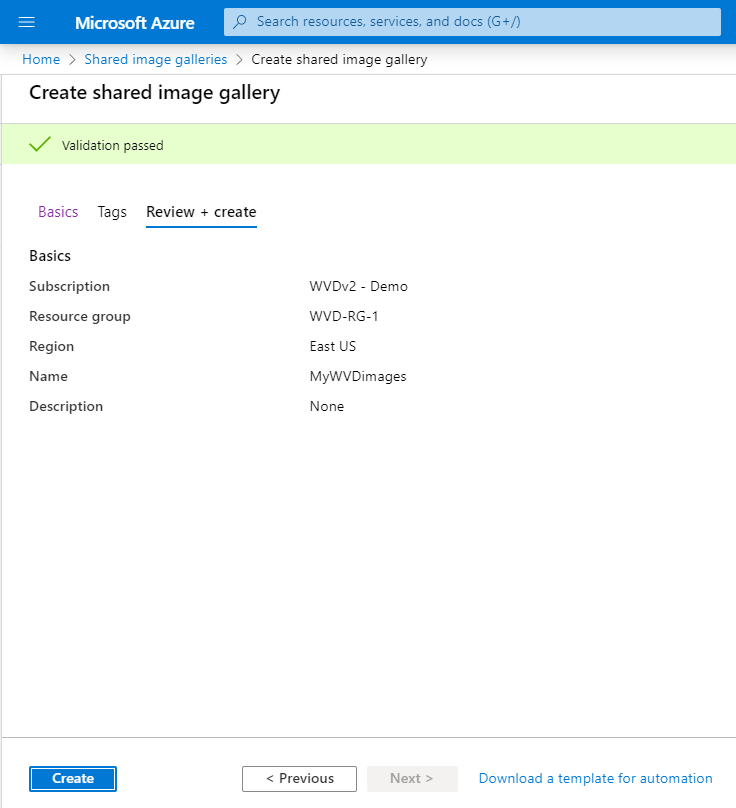
Open the new created Gallery
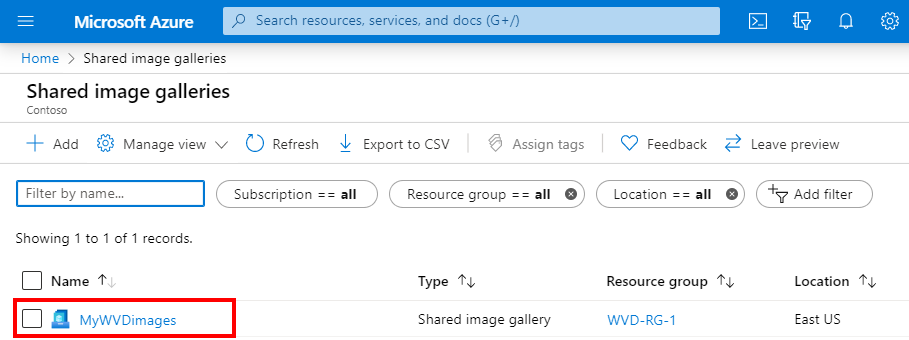
Click on + Add new image definition

Make full in the required data as like beneath
Click on Adjacent: Version
Note: EMS stands for (Windows ten) Enterprise multi-session.

Give in a major/small patch number for doing proper versioning. Take over the settings as beneath based on your pre-created Azure Managed image.
Select the different regions y'all desire to make this epitome available in. Y'all can select multiple when your AVD deployment is global! Pretty cool though.😊
Click on Next: Publishing options
Annotation: The epitome version name should follow Major(int).Small-scale(int).Patch(int) format. For instance: 0.0.1, one.5.13. Also, brand sure the setting "Exclude from latest" stays on No.
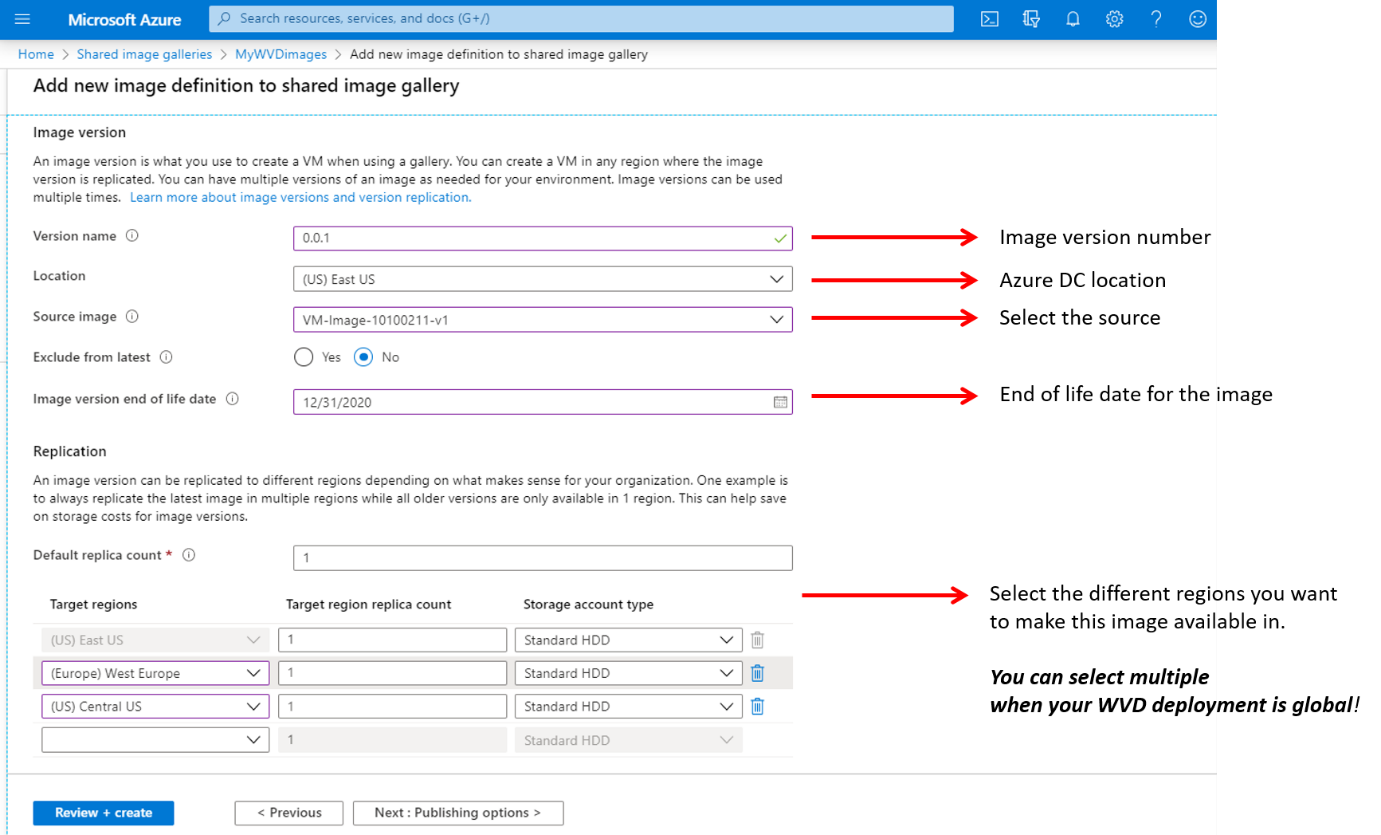
The following settings are optional and only recommendation that we not going to utilize every bit we define the size via the host pool enrolment procedure of Azure Virtual Desktop.
Click on Review + create
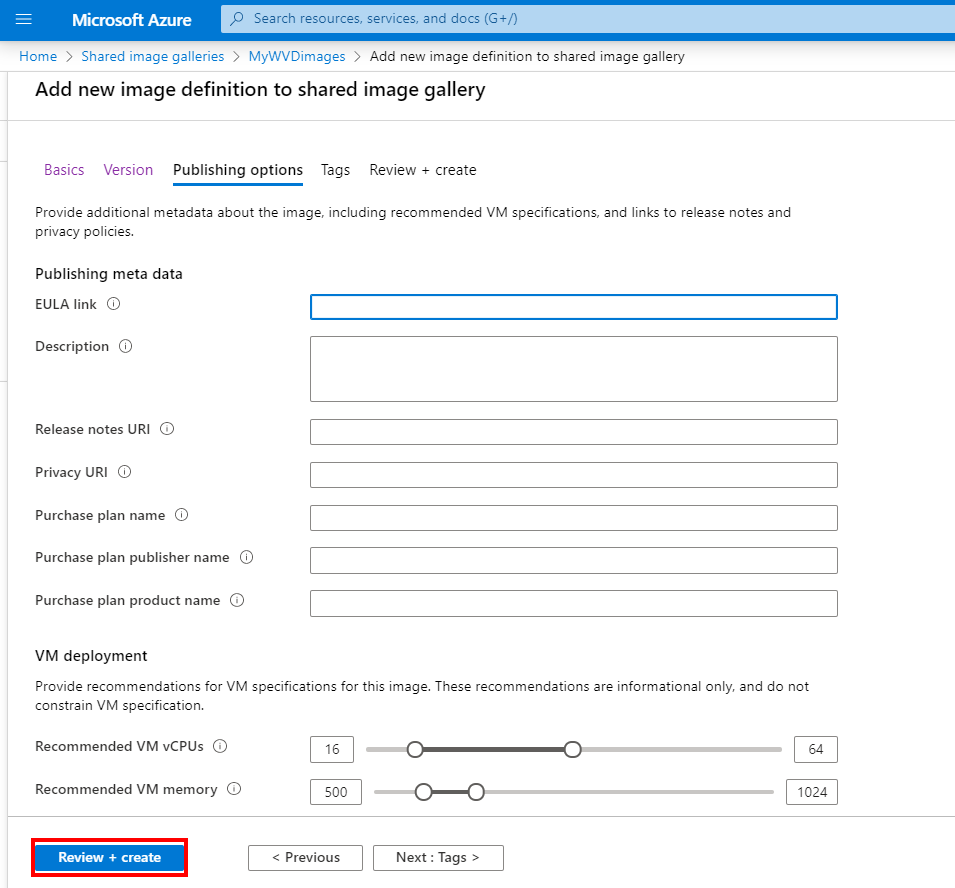
Click on Create
Your Shared Gallery paradigm (s) (SIG) will now be created and distributed beyond the different regions and set to utilise as source for the side by side steps!
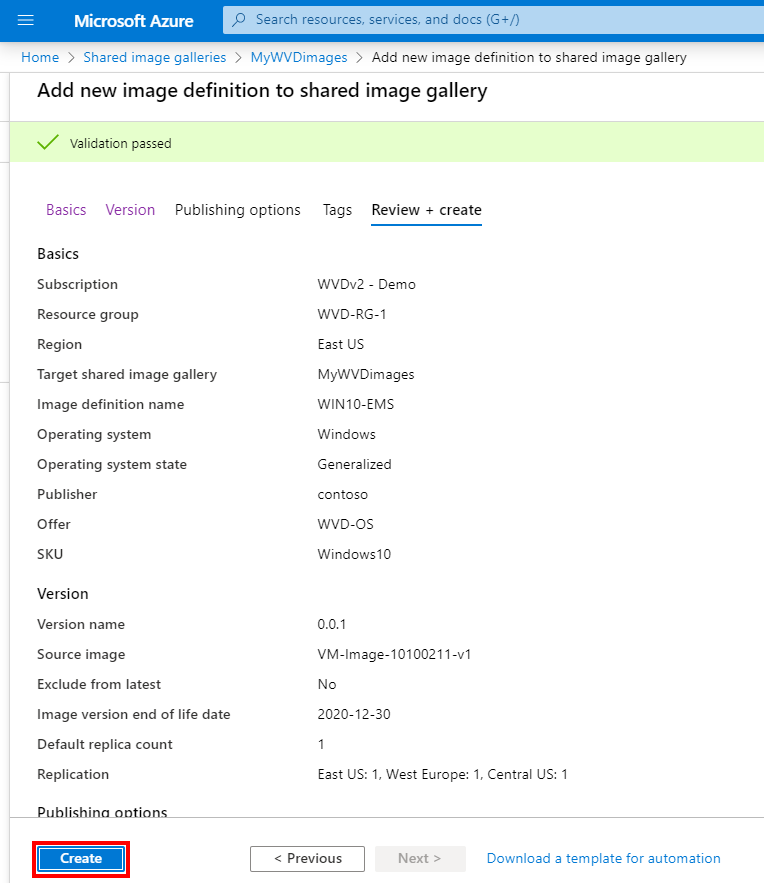
Perform the Microsoft.DesktopVirtualization resource provider registration
Open up the Azure Subscriptions services bill of fare

Open the Azure subscription where y'all are going to deploy your Azure Virtual Desktop environment
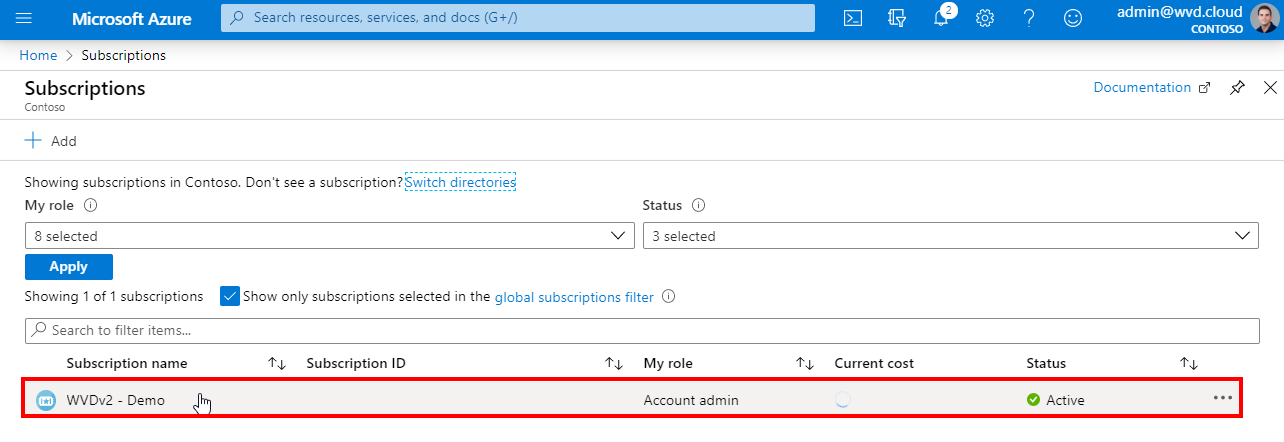
Click on Resource providers
Search for the Microsoft.DesktopVirtualization – provider and click Register
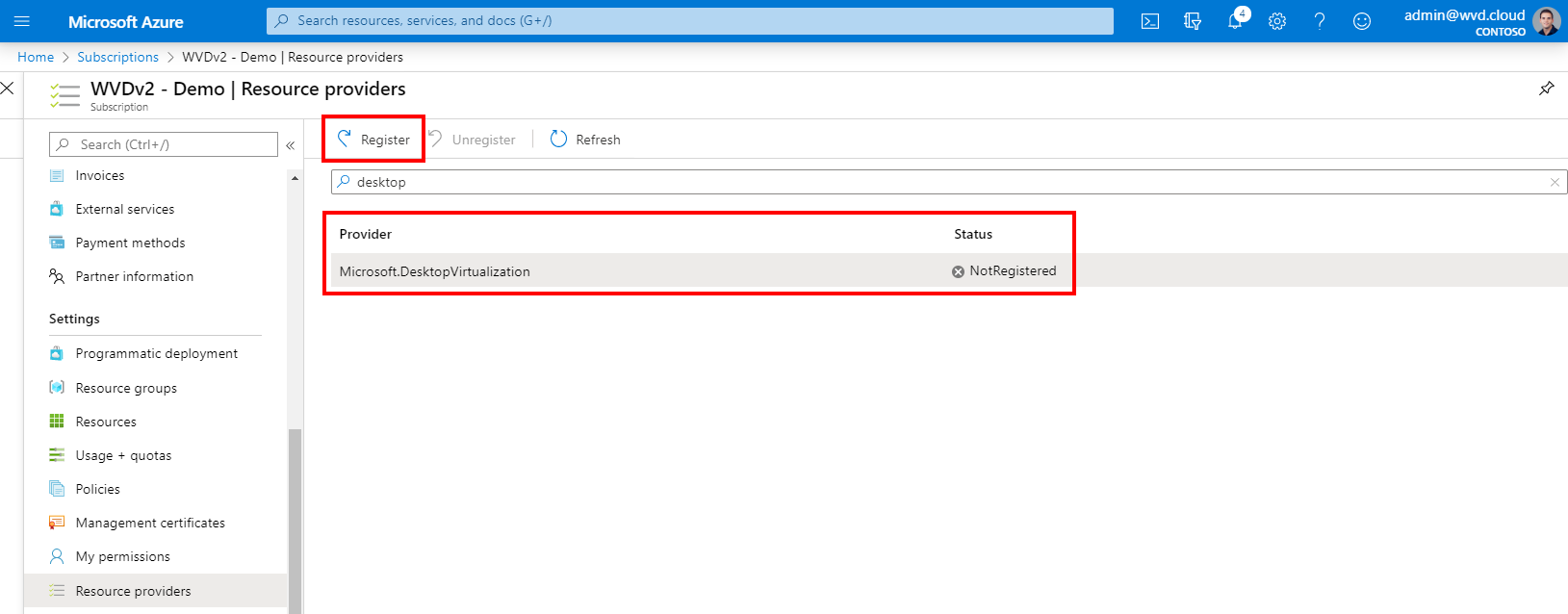
Confirm the registration. At that place must be a green checkbox adjacent to the Microsoft.DesktopVirtualization provider every bit in the screenshot beneath.

Now nosotros are done with the pre-steps. We can at present start with the enrolment process.
Create your host pool
Now we come to the bespeak where nosotros can employ our master paradigm as baseline of our deployment. A host pool is a collection of session hosts (right now based on Windows 10 – Multi User, however Windows vii and Server 2012 R2 and higher is supported equally well). We can apply them later on to assign our Desktops and Published Apps to.
Search for Azure Virtual Desktop in the Azure menu
Note: The new ARM templates for Azure Virtual Desktop ARM-based to automate your deployment are now available for download hither.

Create a host pool
Click on Create a host pool
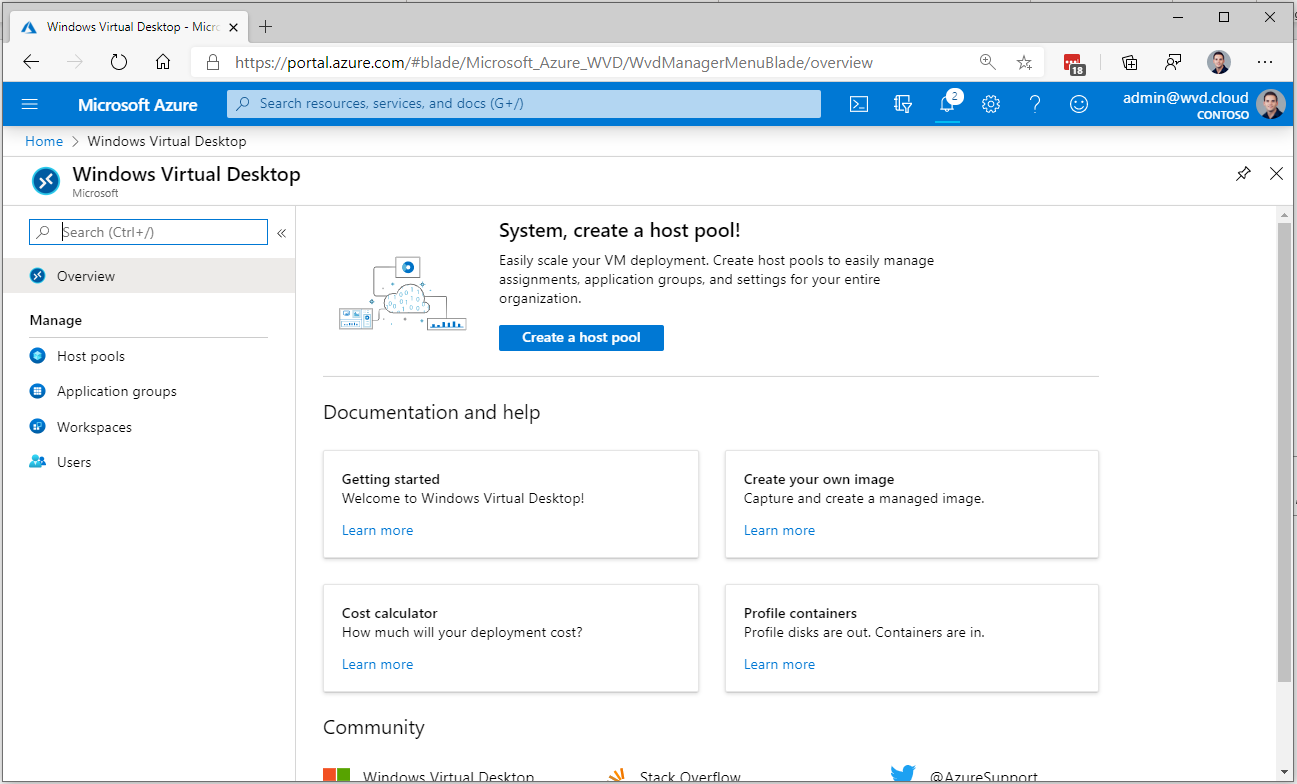
Cull your subscription, metadata location and host pool properties
Click on Next: Virtual Machines
02.17.2021: Metadata locations are now besides active in Northward and West Europe every bit a selection selection. This location cannot exist changed subsequently.
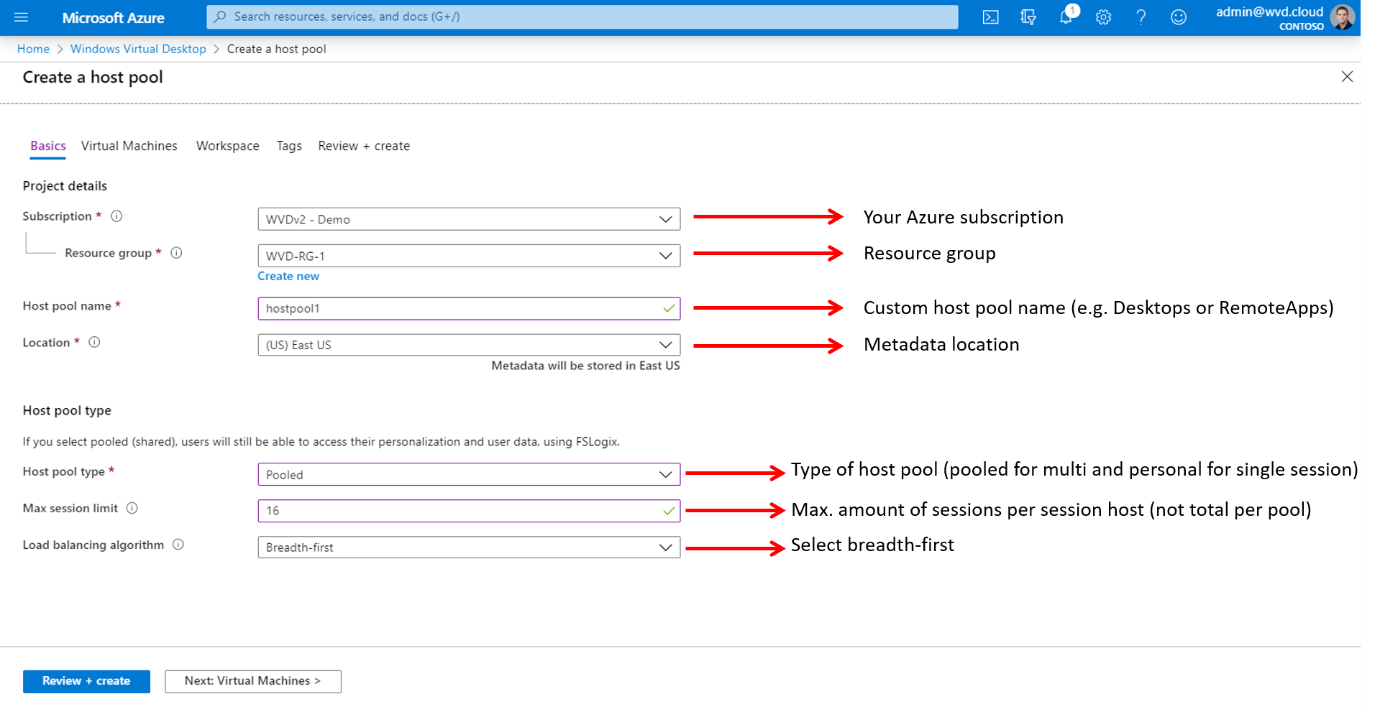
Using Windows x unmarried session? Make sure to alter the host pool blazon to personal .

VM details
First click on Yeah

Give in the VM details –select the size and image for your enrolment.
Annotation: Office 365 ProPlus has been renamed to Microsoft 365 Apps for Enterprise.
Annotation: Yous tin deploy in West Europe, this Azure datacenter location is where you deploy your virtual desktop – session hosts in. This is independent of the metadata location.
Note: Session hostnames cannot exceed 10 characters due to the machine-count prefix that comes extra.
Note: The following three articles lists the maximum suggested number of users per virtual central processing unit of measurement (vCPU) and the minimum VM configuration for each workload. This could be helpful to run into what your first interpretation of VMs equally role of your host pool.
- Multi-session recommendations
- Single-session recommendations
- General virtual machine recommendations
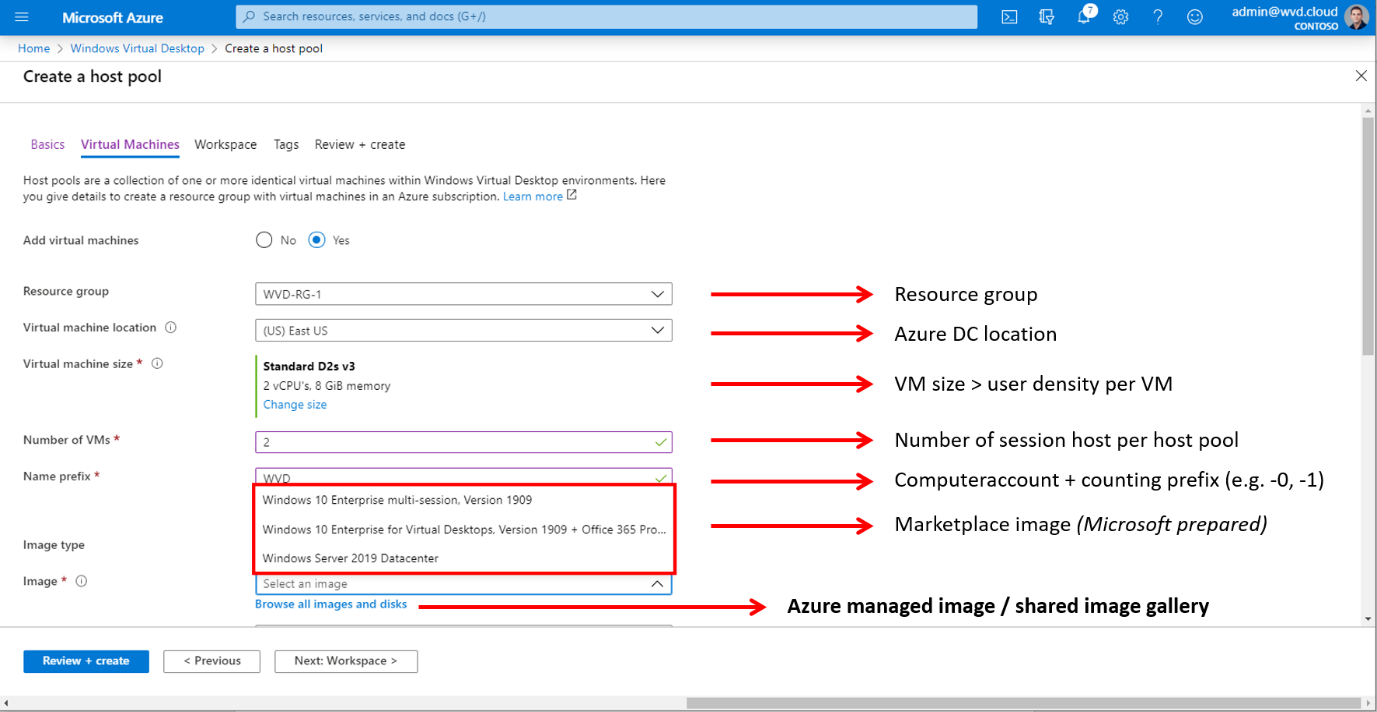
Select your image blazon
Skip this stride here if you are not using a custom image, and decided to go for i of the Market images (Microsoft prepared). Yous must install apps, and agents such as FSLogix and OneDrive afterward.
Click on Browse all Images
1: My image. You can now besides instantly update host pools that are created based on Azure Managed images (images nether My images) as part of the host pool.
Note: It's now possible to change this option afterwards the creation of the host pool, too Azure Managed images!
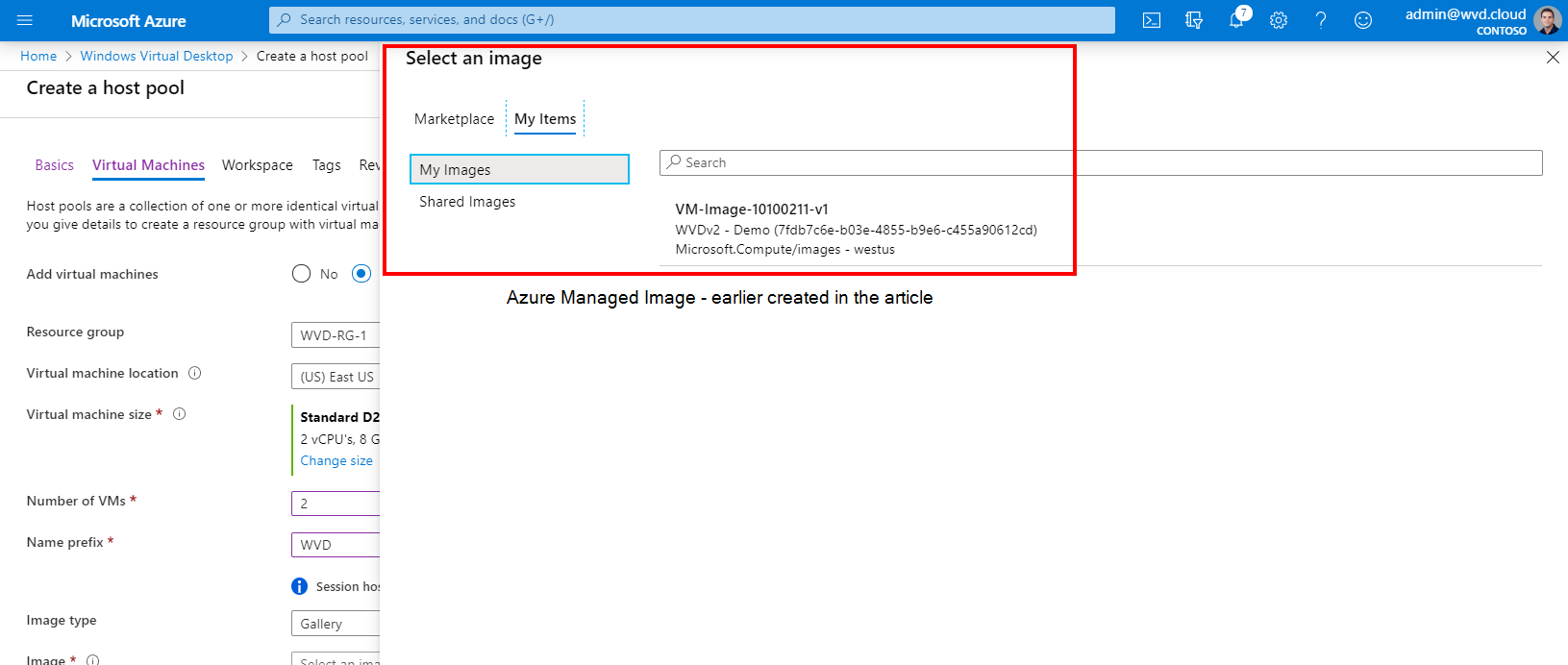
2: Shared images (SIG). The Azure shared image gallery (SIG) comes in very handy due to the support for versioning likewise as global image replication accross regions, read the benefits again here. It will automatically choice and select the latest image version.
In one case you lot need to update your existing host puddle, you but take to deploy new session host VMs and drain quondam VMs and your host puddle is upwardly to date once more! I'll explicate how you update the paradigm afterward here.

Select our custom created Windows 10 Enterprise multi session Azure Managed image / or the one from the shared prototype gallery (SIG)
Note: New feature. Information technology's at present possible to change this option after the cosmos of the host pool (while clicking on "Add virtual machines to a host pool), also Azure Managed images!
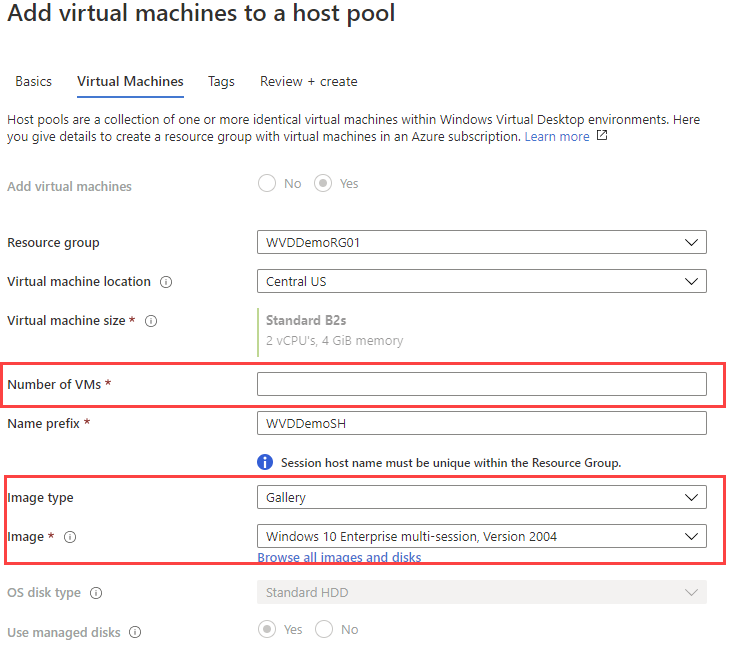
Network and security
Provide the backdrop for your Azure Virtual Network to bring together your session hosts in.
Note : Make sure that the DNS servers of your Azure VNET are pointing to the domain controllers DNS servers to make sure the FQDN tin be resolved!
Note : Also make certain that all the URLs below are reachable from that VNET!


Administrator account
Enter in a service business relationship to join your session hosts to your AD (Kerberos – ADDS) domain
Click on Next : Workspace

Create the Workspace
The Workspace is the new proper name for tenant. We tin now create this direct do this in the Azure Portal instead of using PowerShell before!
Click on Aye and Create new

Give in a name for your Workspace (tenant)
Click on Ok

Click on Review + Create

Start the enrolment
Review your settings – click on Create to start the deployment
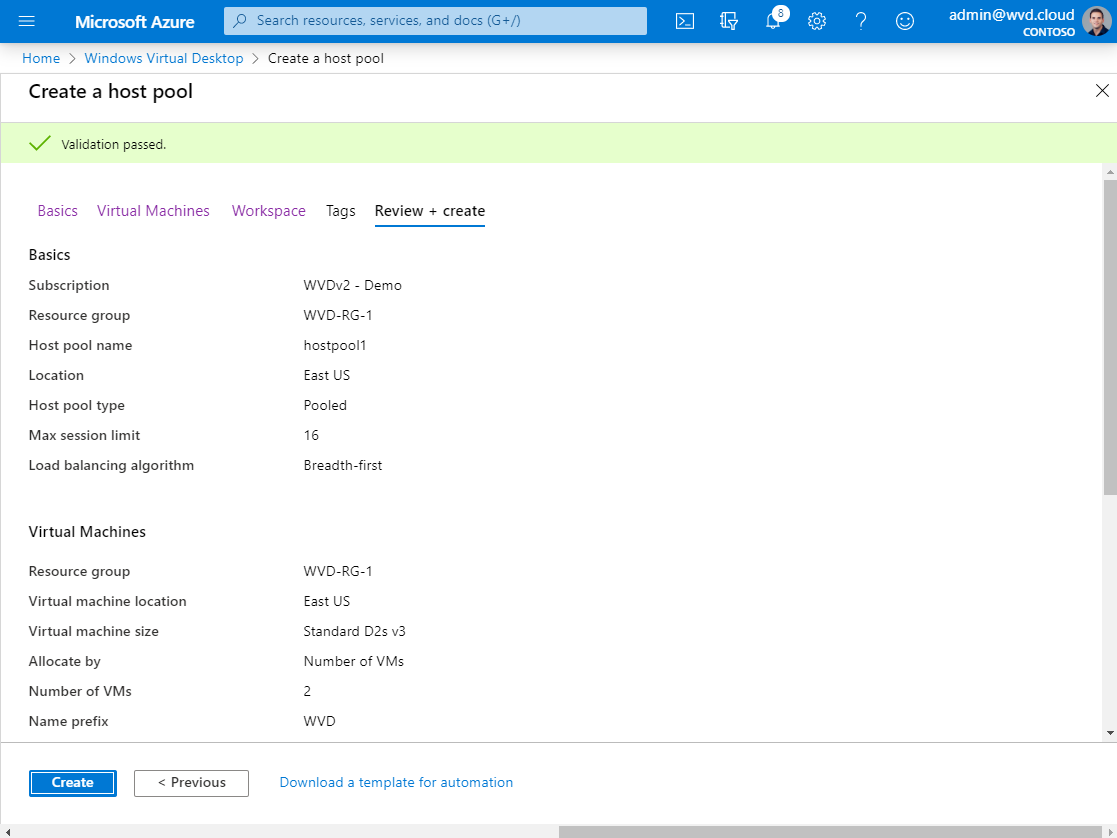
Create and Assign Remote Applications (to AAD Groups!)
The process of publishing applications has get easier as well. First yous must create a application group based on Remote app as blazon.
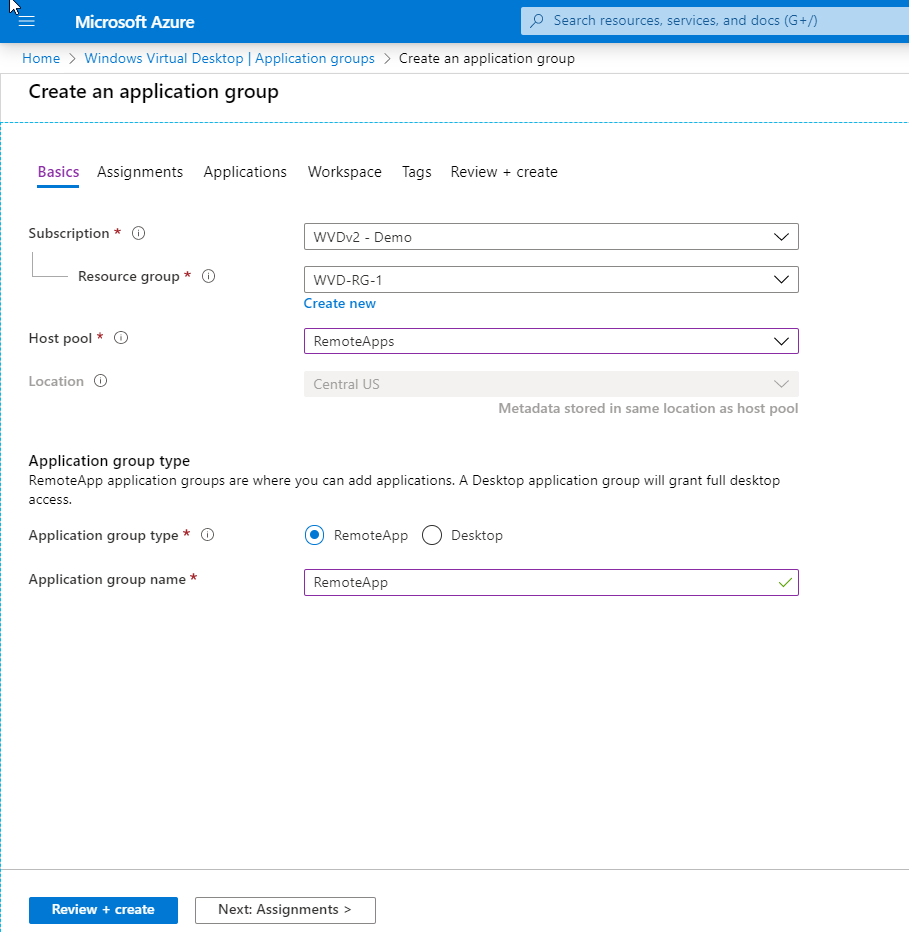
Select your host pool and resource group properties

Select either a user or Azure AD group to make information technology more Dynamic. Yes we support Azure AD groups!

Add your (Remote) application from the start carte from the session host to publish
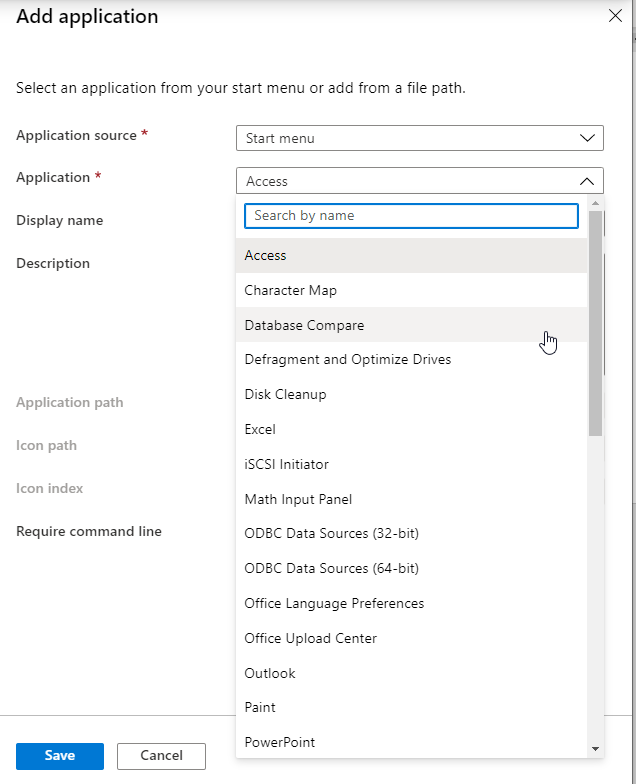
Select your Workspace
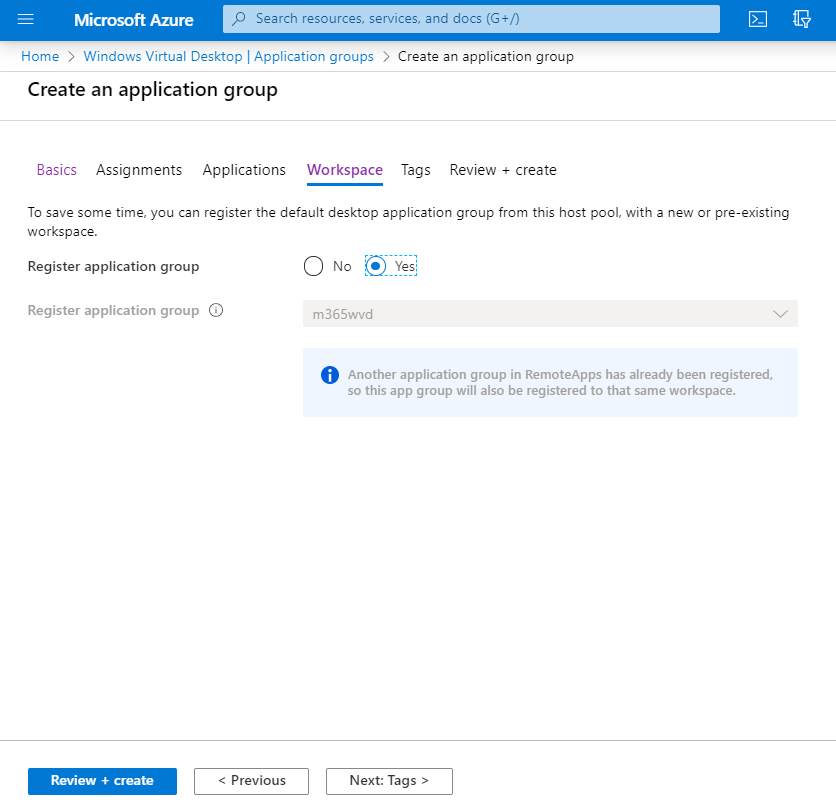
You tin can also easily adjust existing host pools (RemoteApp) and add together new Applications on the wing!

Add together session hosts to existing host pool
Great enhancement. Since the new ARM based Portal release – you are able to expand host pools hands based on existing images.
Annotation: T he designated ARM templates that can do this volition follow afterwards.
Click on + add in the host pool

Follow the requirements and add actress machines to the host pool!
Note: This procedure works for also Azure managed images and shared images. You can at present change the source of the Image as well. This is slap-up news for paradigm updates.
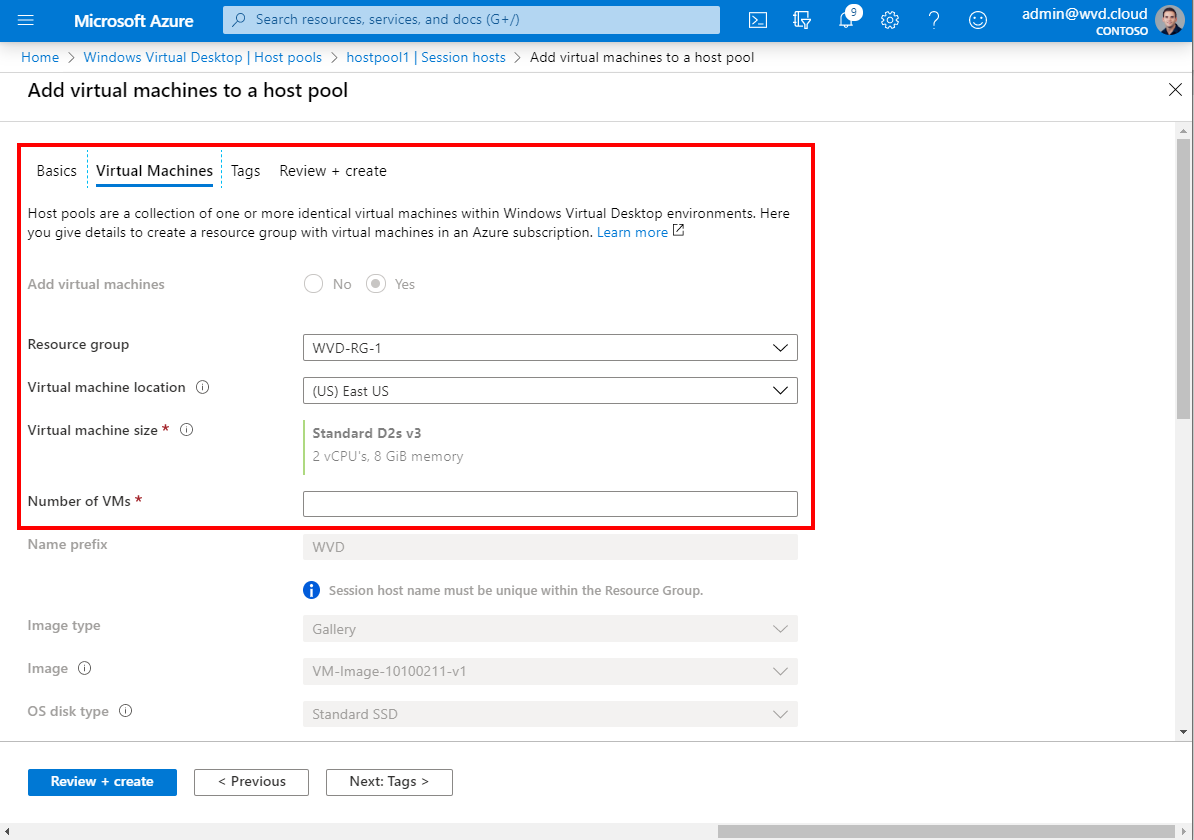
Update the host pool images – create a new image version
The maintenance process of your Azure Virtual Desktop environment is merely every bit important as the enrolment process. The prior created Azure Managed Paradigm – we used as custom prototype can be used again to use as baseline to provide the extra updates on elevation. .
First you lot need to apply your updates to your prototype. This apparently could be annihilation, such as LOB application updates, agents or but the FSLogix client as instance.
You can create a new Virtual Machine from the Virtual Machines (IaaS) menu (not the host pool this comes afterwards) with the previous version (or another version if you lot want to revert more changes) – and spin that machine upward.

Select the source version– it will automatically pick the latest version.

After the VM enrolment is done, install all the updates on the VM. This can be washed automatic or manually (apply RDP or Azure Bastion to secure remote into the VM – image)
Now we demand to sysprep (generalize) the machine and make sure to capture it again as image.
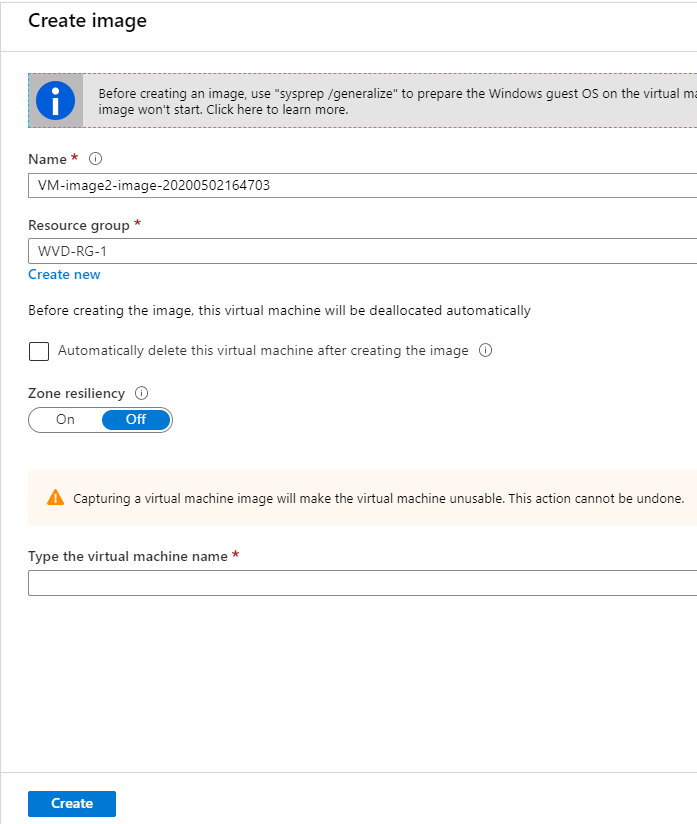
Go back to your Shared image gallery
Open your existing shared paradigm, for me that'll be WIN10-EMS
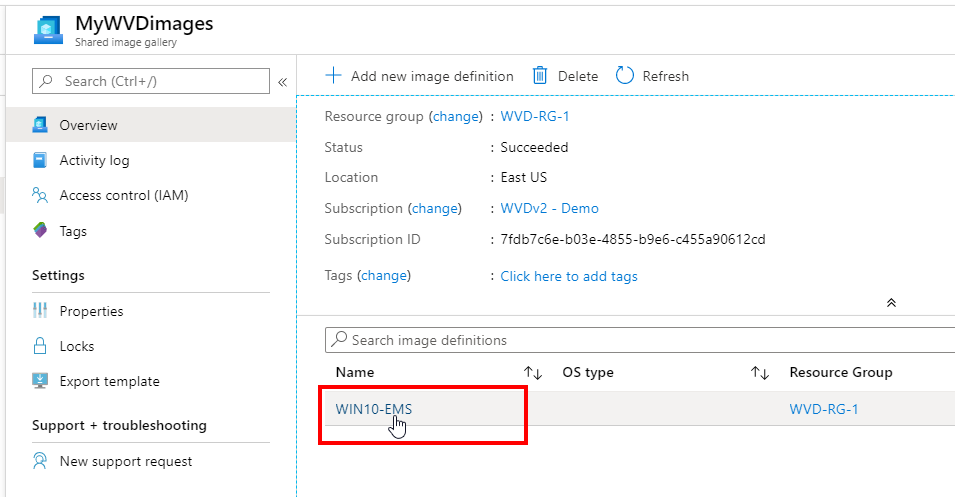
click on + add version
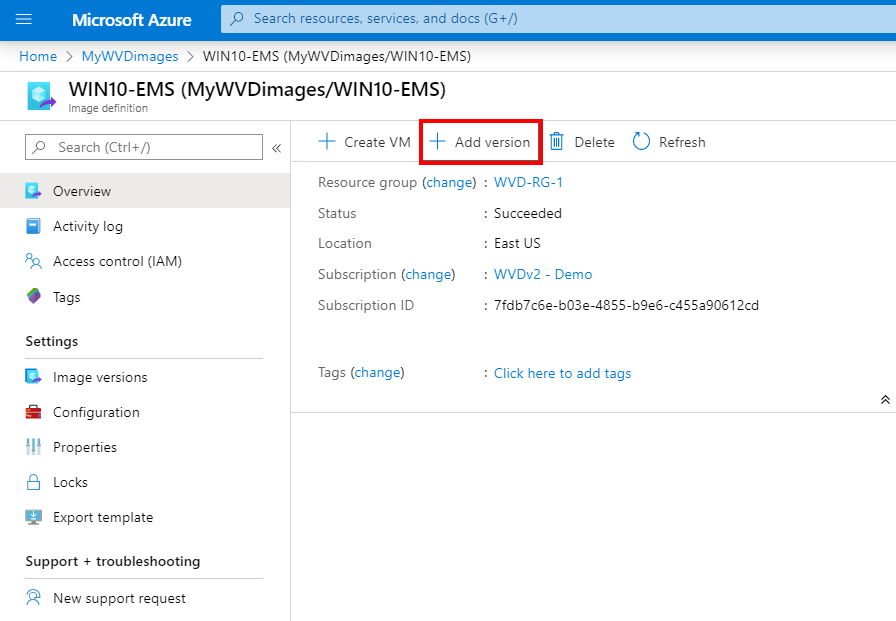
This is the most important part. Make sure to select the new Azure Managed prototype (from the last capture procedure) as source with (of course) a new versioning number to make sure the host pool enrolment picks the latest newest version every bit default .
Select the End of life appointment and DC locations (if whatsoever) to make this new image available in as well.
Click on Review + create
Note: Make sure that the option, Exclude from latest is set up to NO. If this setting isn't configured in the correct manner – the host pool process will not choice the latest version every bit source!
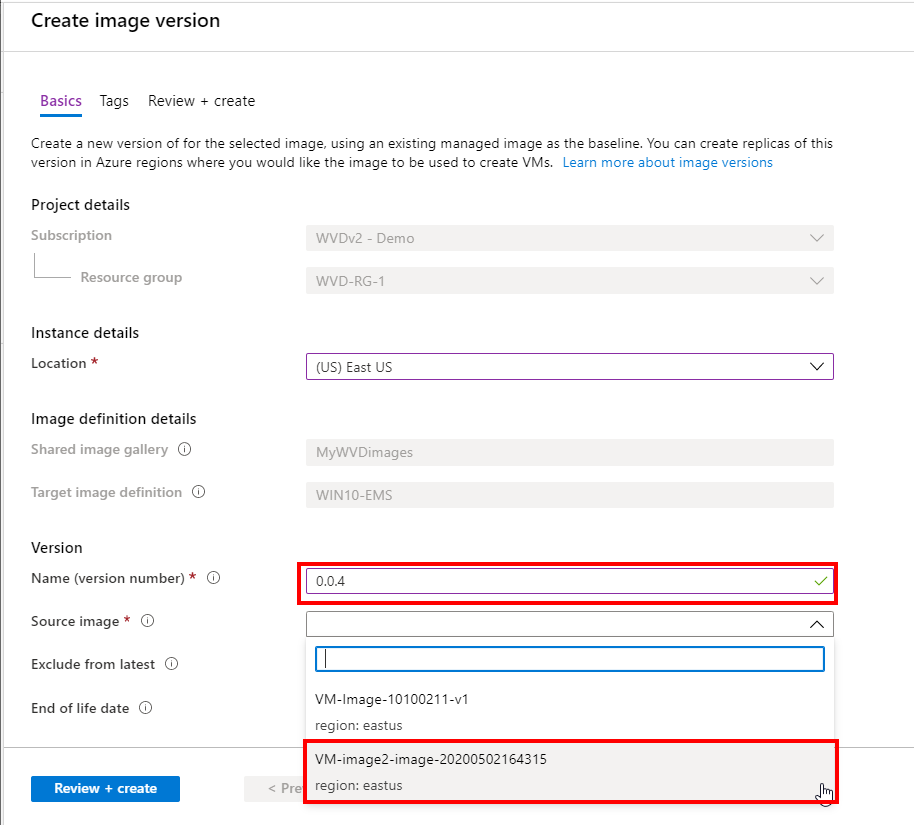
Click on Create
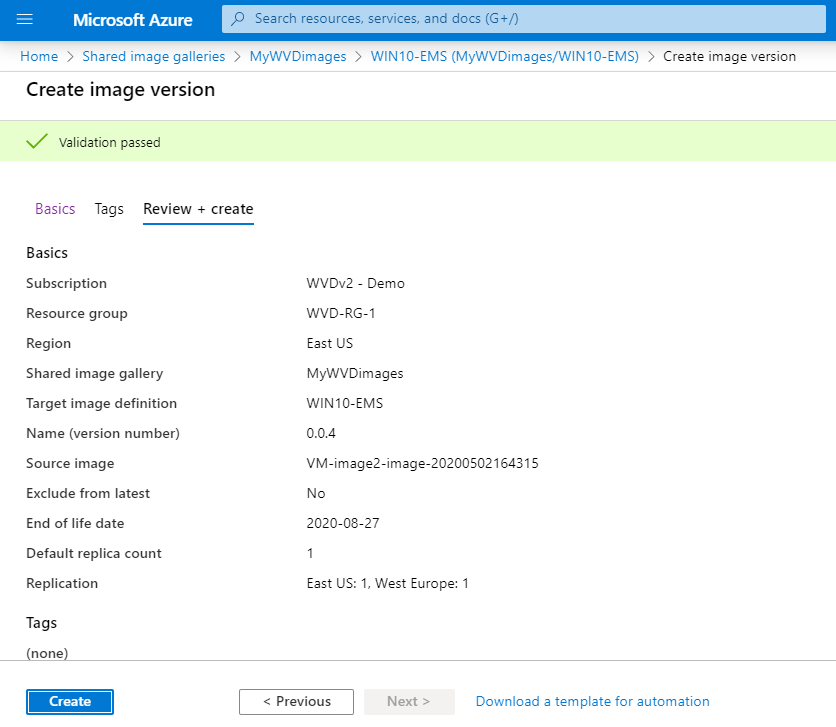
We can start with adding sessions hosts to the designated host pool.
Go to your host pool that was previously configures with shared images (SIG) as source.
Click on + Add
Note : Nosotros are adding extra machines to the host pool . Make sure to put the older versions in drain mode, or remove them to make sure new user sessions are logging on to the new paradigm version.
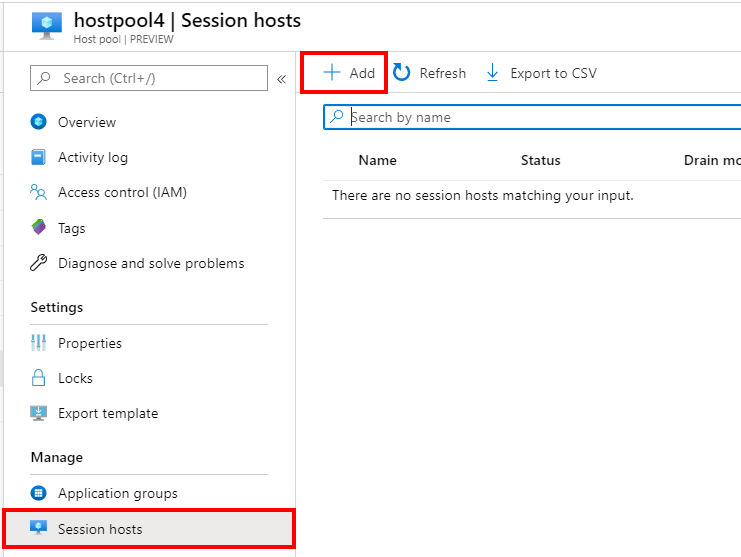
Click on Virtual Machines
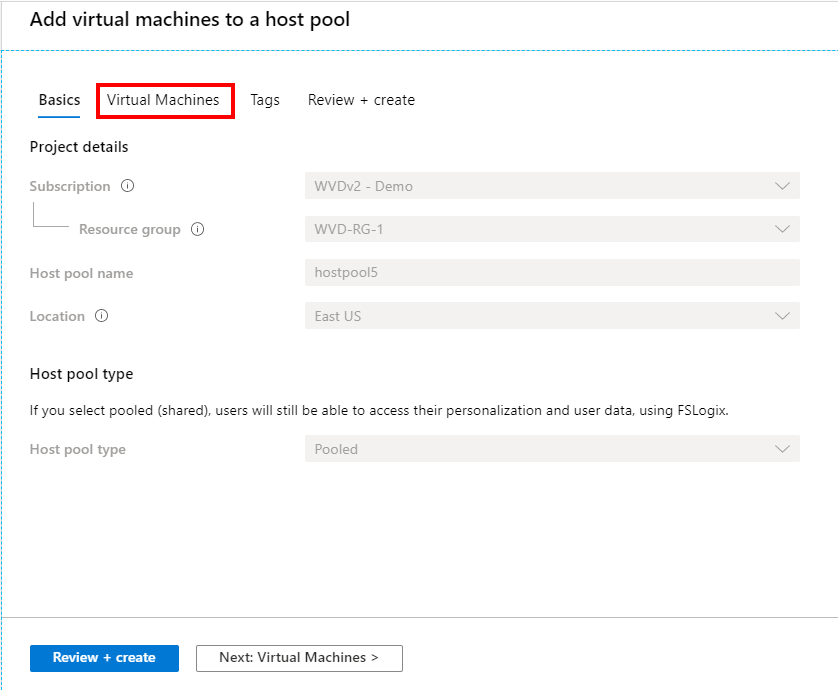
Enter in the Number of VMs to add/update to the host pool (based on the new prototype – that'due south why the numbering and latest setting is so important while creating the host pool).
Note: As said before. Information technology's at present possible to modify the source of the image – this is a great comeback that leaves you in the position to alter more easier to Azure Managed Images versions – or potentially swaps betwixt SIG.

Select your Azure Virtual Network (VNET) and Advertizement join service account credentials.
Click on Review + create
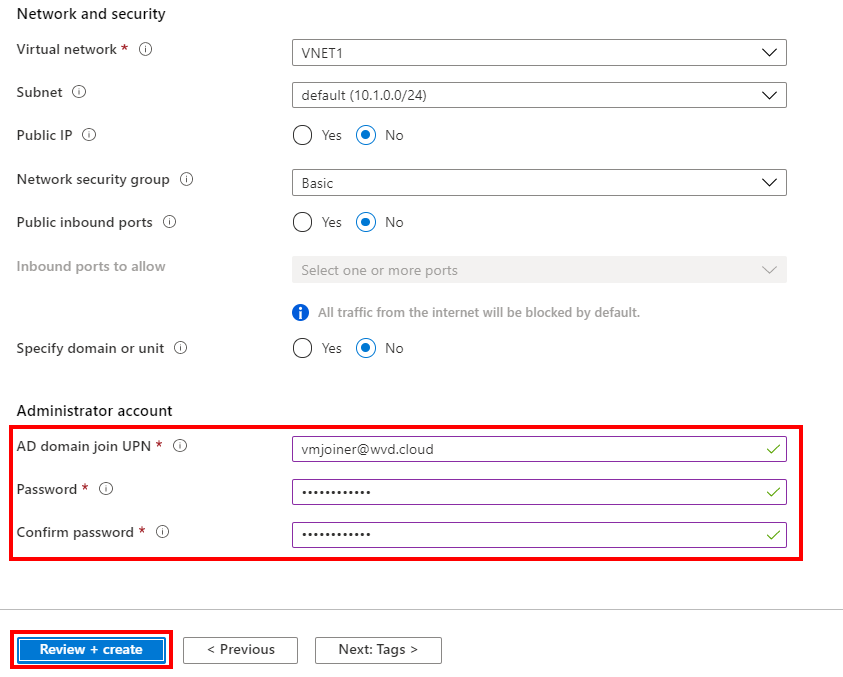
Click on Create

Postal service-enrolment host pool automation (optional)
Annotation: You can too add machines manually to the host pool by installing the AVD Agent and bootloader on your virtual auto – during the installation it will inquire for a token. You can request (or create a new i) via this PoSH commandConsign-AzAVDRegistrationInfo to create a new registration token – or Get-AzWvdRegistrationInfo to export an existing token. Download the Azure Virtual Desktop Agent and bootloader the Azure Virtual Desktop Agent Bootloader hither. You can use the silent (automatic) commands beneath to install the AVD agents without manual interaction in each VM! Ane for the AVD agent and the other one for the AVD bootloader agent.
AVD Amanuensis command
Start - Process - FilePath "msiexec.exe" - ArgumentList "/i $AgentInstaller" , "/tranquility" , "/qn" , "/norestart" , "/passive" , "REGISTRATIONTOKEN=$RegistrationToken" , "/fifty* C:\Users\AgentInstall.txt" - Wait - Passthru
Bootloader control
Start - Process - FilePath "msiexec.exe" - ArgumentList "/i $AgentBootServiceInstaller" , "/serenity" , "/qn" , "/norestart" , "/passive" , "/l* C:\Users\AgentBootLoaderInstall.txt" - Wait - Passthru
Change the proper name of your Workspace
It could be helpful and more customer friendly to change the proper noun of the Azure Virtual Desktop environment to Azure Virtual Desktop like in the example beneath, or your client name. I'll explain how you can do that.

Go to your Workspace properties in the Azure Portal and change the Friendly Name

Change the proper noun of your Virtual Desktops
The same for your Virtual Desktop names. There's also an option to change them something custom such as Session Desktop equally example below.

Get to the Application Group and open the properties
Change the friendly name to anyone y'all similar
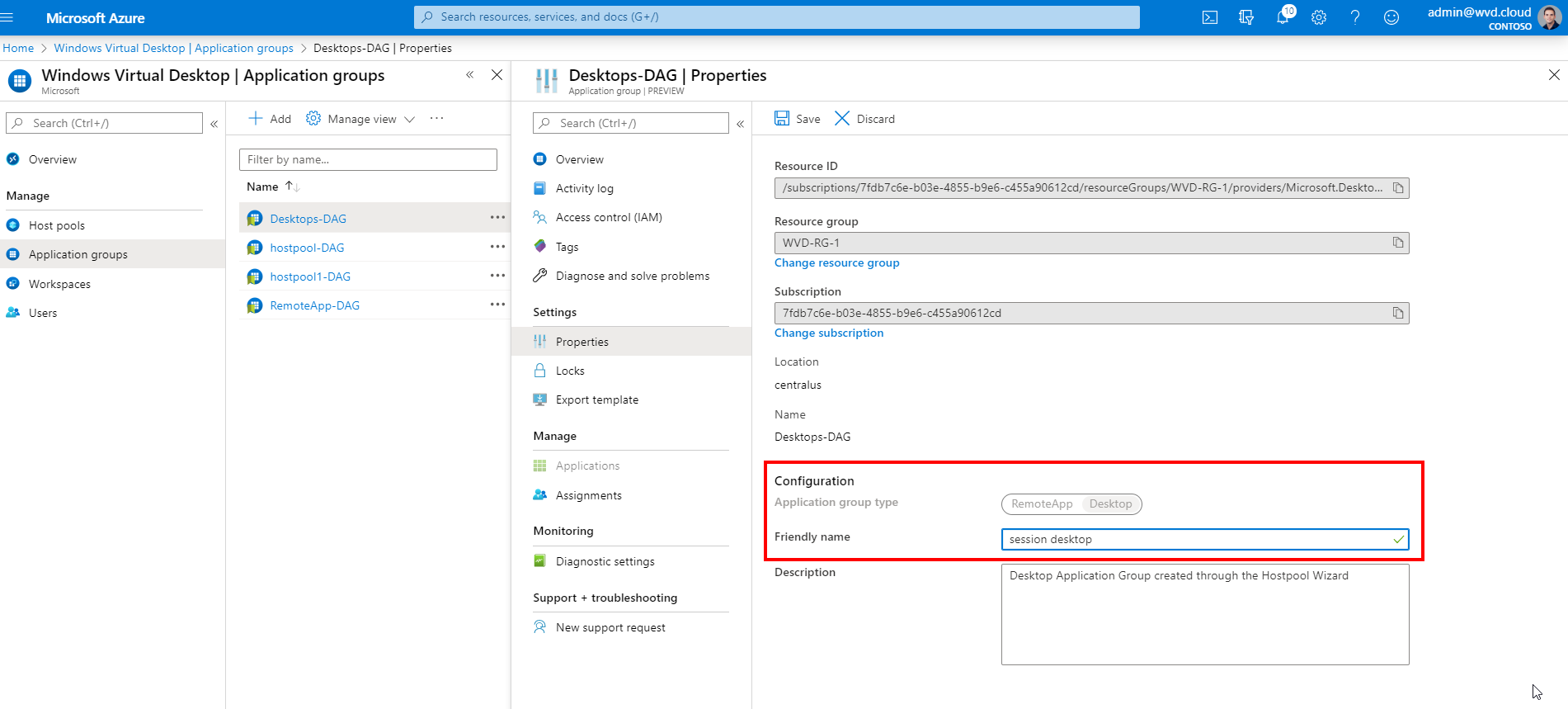
Install the Azure Virtual Desktop Client
To run your Azure Virtual Desktop – Full Desktops or RemoteApps directly from the customer and/or start menu, you must install the AVD Client.
Download the AVD client below
http://aka.ms/wvd/clients/windows
Start the AVD Client – Desktop app
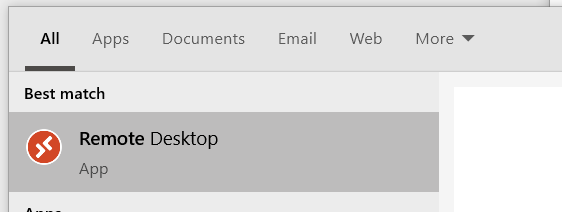
Click subscribe with URL
Enter the following ARM-based – https://rdweb.wvd.microsoft.com/api/arm/feeddiscovery – URL.

Do you prefer to enter your organization's email?
Please make sure to create the post-obit TXT DNS record in your verified domain that you lot utilise inside Azure AD every bit principal domain. Afterward that, you will be able to instruct your users to enter in the electronic mail address only.
DNS Settings
| Name | Type | TTL | TTL |
| _msradc | TXT | i | Hours |
| Value |
| https://rdweb.wvd.microsoft.com/api/arm/feeddiscovery |
Continue with the client configuration steps.
Enter a user that has a desktop or apps applied.
Click on Side by side
Enter your credentials
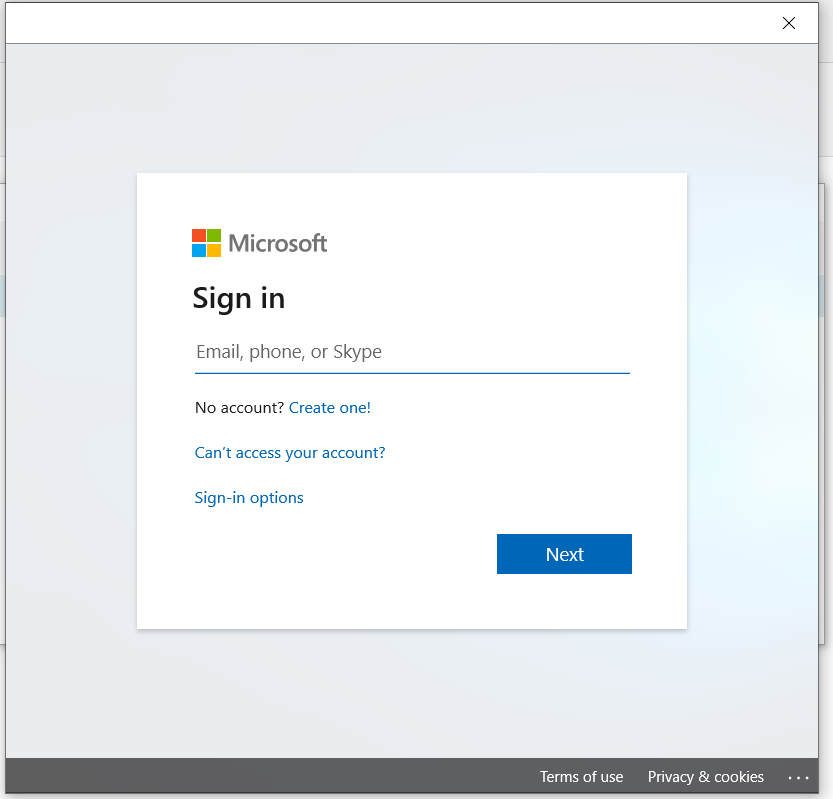
Provide Azure MFA (if activated).
Note: When you use Azure MFA y'all might want to have a look at one of my other manufactures hither as well to enforce or whitelist Azure MFA for your end-users for the Windows Client.
Your RemoteApps and Desktops are ready to use!

Deploy the Remote Desktop Client via Microsoft Endpoint Manager – Intune
I've recently written an article on how to deploy the Remote Desktop (MSRDC) AVD client as Intune Win32 app – via Microsoft Endpoint Manager (MEM) to your concrete clients. You lot'll larn in this article how you can publish the Azure Virtual Desktop Customer Application (MSRDC) to your endpoints via Microsoft Endpoint Director (Intune).
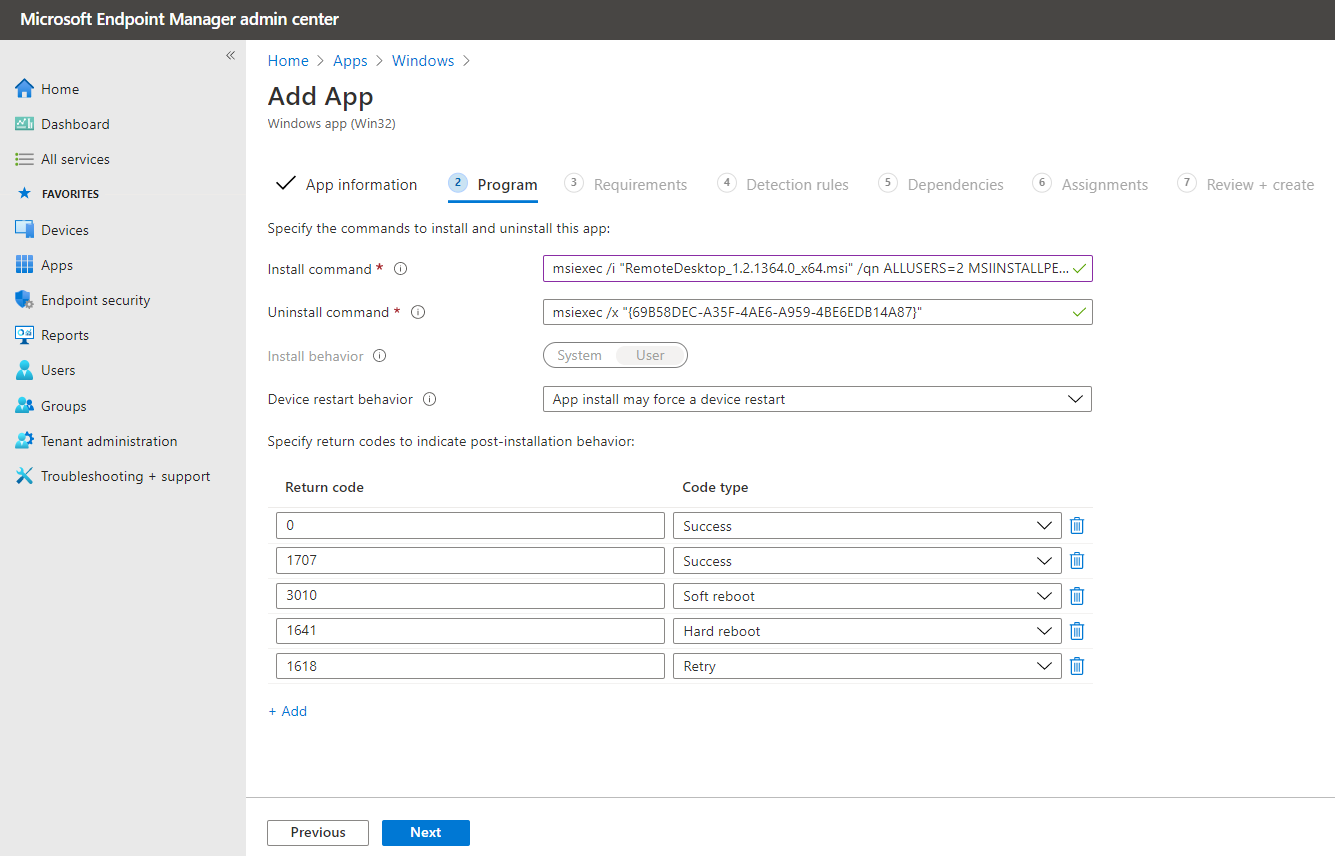
Utilise the HTML5 Web portal
AVD can exist accessed without a customer or amanuensis from a web browser, which can be beneficial when you demand to do some work without having your ain device with you.
To access the RDWeb portal, delight go to the short link https://aka.ms/wvdarmweb or https://rdweb.wvd.microsoft.com/arm/webclient in full length.
Logon with your credentials.

Azure MFA can exist added to this as well. Azure AD Provisional Access features are supported!
If you get access, y'all'll come across all your Desktops and RemoteApps
 We are inside our Windows 10 multi-session – session host, including OneDrive, Teams and Outlook – everything just works 😊!
We are inside our Windows 10 multi-session – session host, including OneDrive, Teams and Outlook – everything just works 😊!

Some extra information regarding customer supports; Azure Virtual Desktop supports the following clients as of today.
This URL goes directly to the official Microsoft download folio to download the AVD client.
- Windows 10
- Windows 7
- Android
- Chromebook*
- Samsung DeX
- HTML5 Web client on Windows, macOS and Linux
- Linux SDK – zero /thinclients (via IGEL Next-gen OS)
- Which basically means every device is supported with a HTML5 browser installed.
Go along in listen to open up up the URLs and ports beneath from your client network surroundings to make AVD work. You lot can find the total list hither.

Encounter here a comprehensive troubleshooting overview and what to exercise when for feedback and support!
https://docs.microsoft.com/en-us/azure/virtual-desktop/troubleshoot-set-up-overview
Hope to run across y'all back soon – and feel free to exit a comment if you've any questions.
Want to run into everything above in activity?
I recently was a guest at the famous Azure Fri (aqueduct nine) bear witness with Scott Hanselman. I talk most almost everything that y'all learn in this article all the same in all live demos. Sentry it dorsum below.
How To Determine What Port Citrix Vda Registered On,
Source: https://christiaanbrinkhoff.com/2020/05/01/windows-virtual-desktop-technical-2020-spring-update-arm-based-model-deployment-walkthrough/
Posted by: smithgoidesseem.blogspot.com

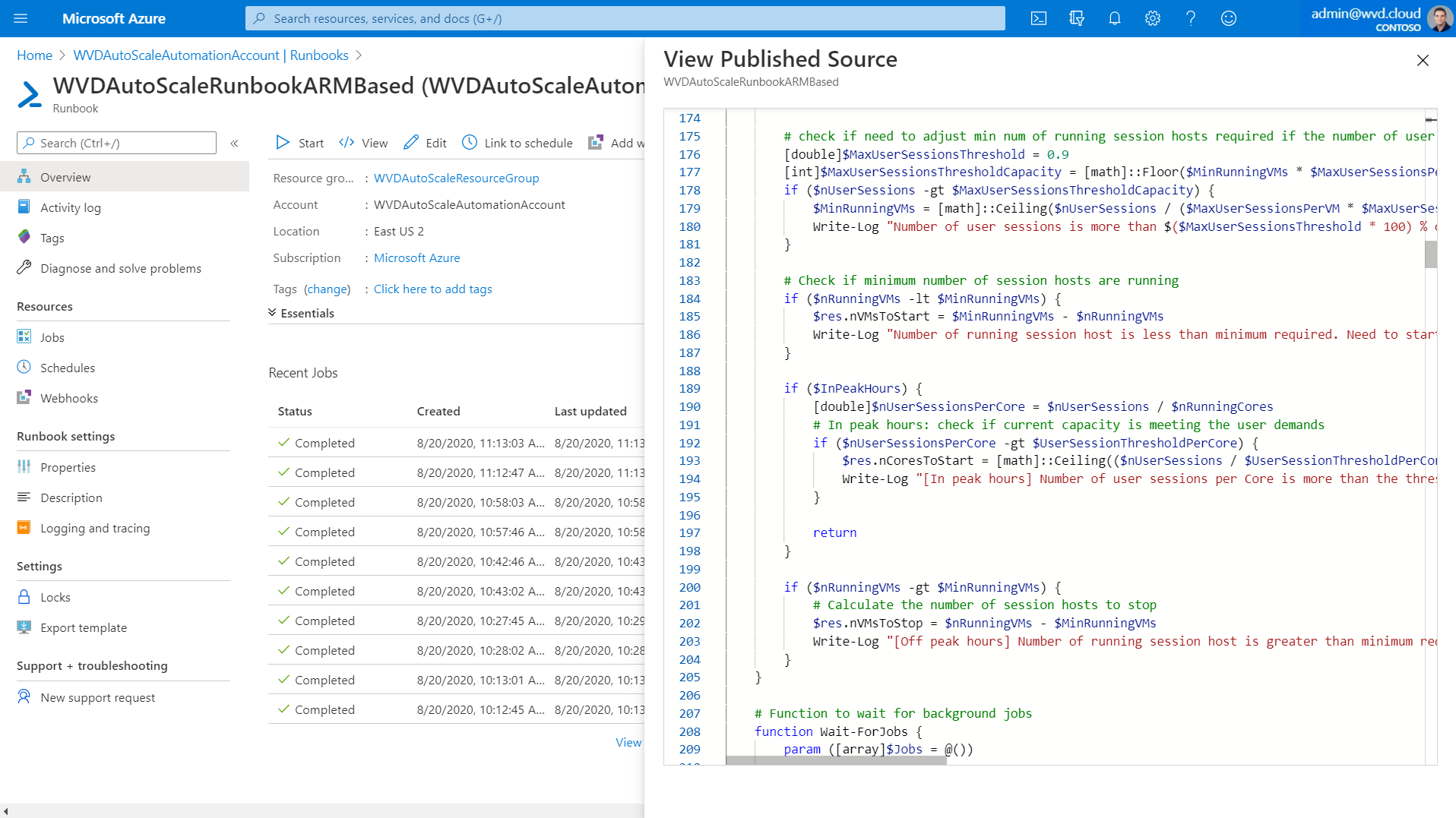

0 Response to "How To Determine What Port Citrix Vda Registered On"
Post a Comment